Question
Given \(f (x) = x^2 − 3x^{−1}, x \in {\mathbb{R}}, – 5 \leqslant x \leqslant 5, x \ne 0\),
A football is kicked from a point A (a, 0), 0 < a < 10 on the ground towards a goal to the right of A.
The ball follows a path that can be modelled by part of the graph
\(y = − 0.021x^2 + 1.245x − 6.01, x \in {\mathbb{R}}, y \geqslant 0\).
x is the horizontal distance of the ball from the origin
y is the height above the ground
Both x and y are measured in metres.
Write down the equation of the vertical asymptote.[1]
Find \(f ′(x)\).[2]
Using your graphic display calculator or otherwise, write down the coordinates of any point where the graph of \(y = f (x)\) has zero gradient.[2]
Write down all intervals in the given domain for which \(f (x)\) is increasing.[3]
Using your graphic display calculator or otherwise, find the value of a.[1]
Find \(\frac{{dy}}{{dx}}\).[2]
(i) Use your answer to part (b) to calculate the horizontal distance the ball has travelled from A when its height is a maximum.
(ii) Find the maximum vertical height reached by the football.[4]
Draw a graph showing the path of the football from the point where it is kicked to the point where it hits the ground again. Use 1 cm to represent 5 m on the horizontal axis and 1 cm to represent 2 m on the vertical scale.[4]
The goal posts are 35 m from the point where the ball is kicked.
At what height does the ball pass over the goal posts?[2]
Answer/Explanation
Markscheme
equation of asymptote is x = 0 (A1)
(Must be an equation.)[1 mark]
\(f ‘(x) = 2x + 3x^{-2}\) (or equivalent) (A1) for each term (A1)(A1)[2 marks]
stationary point (–1.14, 3.93) (G1)(G1)(ft)
(-1,4) or similar error is awarded (G0)(G1)(ft). Here and also as follow through in part (d) accept exact values \( – {\left( {\frac{3}{2}} \right)^{\frac{1}{3}}}\)for the x coordinate and \(3{\left( {\frac{3}{2}} \right)^{\frac{2}{3}}}\) for the y coordinate.
OR \(2x + \frac{3}{{{x^2}}} = 0\) or equivalent
Correct coordinates as above (M1)
Follow through from candidate’s \(f ′(x)\). (A1)(ft)[2 marks]
In all alternative answers for (d), follow through from candidate’s x coordinate in part (c).
Alternative answers include:
–1.14 ≤ x < 0, 0 < x < 5 (A1)(A1)(ft)(A1)
OR [–1.14,0), (0,5)
Accept alternative bracket notation for open interval ] [. (Union of these sets is not correct, award (A2) if all else is right in this case.)
OR \( – 1.14 \leqslant x < 5,x \ne 0\)
In all versions 0 must be excluded (A1). -1.14 must be the left bound . 5 must be the right bound (A1). For \(x \geqslant – 1.14\) or \(x > – 1.14\) alone, award (A1). For \( – 1.4 \leqslant x < 0\) together with \(x > 0\) award (A2).[3 marks]
a = 5.30 (3sf) (Allow (5.30, 0) but 5.3 receives an (AP).) (A1)[1 mark]
\(\frac{{{\text{d}}y}}{{{\text{d}}x}} = – 0.042x + 1.245\) (A1) for each term. (A1)(A1)[2 marks]
Unit penalty (UP) is applicable where indicated in the left hand column.
(i) Maximum value when \(f ‘ (x) = 0\), \( – 0.042x + 1.245 = 0\), (M1)
(M1) is for either of the above but at least one must be seen.
(x = 29.6.)
Football has travelled 29.6 – 5.30 = 24.3 m (3sf) horizontally. (A1)(ft)
For answer of 24.3 m with no working or for correct subtraction of 5.3 from candidate’s x-coordinate at the maximum (if not 29.6), award (A1)(d).(UP) (ii) Maximum vertical height, f (29.6) = 12.4 m (M1)(A1)(ft)(G2)
(M1) is for substitution into f of a value seen in part (c)(i). f(24.3) with or without evaluation is awarded (M1)(A0). For any other value without working, award (G0). If lines are seen on the graph in part (d) award (M1) and then (A1) for candidate’s value \( \pm 0.5\) (3sf not required.)[4 marks]
(not to scale)
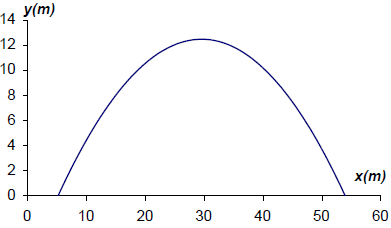 (A1)(A1)(A1)(ft)(A1)(ft)
(A1)(A1)(A1)(ft)(A1)(ft)
Award (A1) for labels (units not required) and scale, (A1)(ft) for max(29.6,12.4), (A1)(ft) for x-intercepts at 5.30 and 53.9, (all coordinates can be within 0.5), (A1) for well-drawn parabola ending at the x-intercepts.[4 marks]
Unit penalty (UP) is applicable where indicated in the left hand column.
(UP) f (40.3) = 10.1 m (3sf).
Follow through from (a). If graph used, award (M1) for lines drawn and (A1) for candidate’s value \( \pm 0.5\). (3sf not required). (M1)(A1)(ft)(G2)[2 marks]
Question
When Geraldine travels to work she can travel either by car (C), bus (B) or train (T). She travels by car on one day in five. She uses the bus 50 % of the time. The probabilities of her being late (L) when travelling by car, bus or train are 0.05, 0.12 and 0.08 respectively.
It is not necessary to use graph paper for this question.
Copy the tree diagram below and fill in all the probabilities, where NL represents not late, to represent this information.
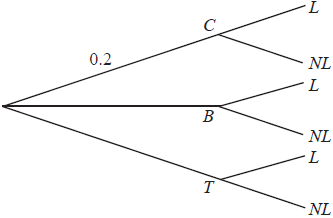 [5]
[5]
Find the probability that Geraldine travels by bus and is late.[1]
Find the probability that Geraldine is late.[3]
Find the probability that Geraldine travelled by train, given that she is late.[3]
Sketch the curve of the function \(f (x) = x^3 − 2x^2 + x − 3\) for values of \(x\) from −2 to 4, giving the intercepts with both axes.[3]
On the same diagram, sketch the line \(y = 7 − 2x\) and find the coordinates of the point of intersection of the line with the curve.[3]
Find the value of the gradient of the curve where \(x = 1.7\) .[2]
Answer/Explanation
Markscheme
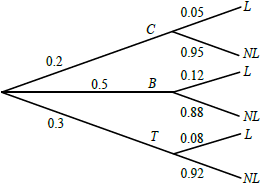
Award (A1) for 0.5 at B, (A1) for 0.3 at T, then (A1) for each correct pair. Accept fractions or percentages. (A5)[5 marks]
0.06 (accept \(0.5 \times 0.12\) or 6%) (A1)(ft)[1 mark]
for a relevant two-factor product, either \(C \times L\) or \(T \times L\) (M1)
for summing three two-factor products (M1)
\((0.2 \times 0.05 + 0.06 + 0.3 \times 0.08)\)
0.094 (A1)(ft)(G2)[3 marks]
\(\frac{{0.3 \times 0.08}}{{0.094}}\) (M1)(A1)(ft)
award (M1) for substituted conditional probability formula seen, (A1)(ft) for correct substitution
= 0.255 (A1)(ft)(G2)[3 marks]
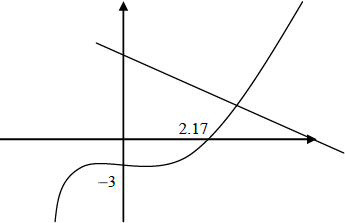 (G3)[3 marks]
(G3)[3 marks]
line drawn with –ve gradient and +ve y-intercept (G1)
(2.45, 2.11) (G1)(G1)[3 marks]
\(f ‘ (1.7) = 3(1.7)^2 – 4(1.7) + 1\) (M1)
award (M1) for substituting in their \(f’ (x)\)
2.87 (A1)(G2)[2 marks]
Question
Consider the functions \(f(x) = \frac{{2x + 3}}{{x + 4}}\) and \(g(x) = x + 0.5\) .
Sketch the graph of the function \(f(x)\), for \( – 10 \leqslant x \leqslant 10\) . Indicating clearly the axis intercepts and any asymptotes.[6]
Write down the equation of the vertical asymptote.[2]
On the same diagram as part (a) sketch the graph of \(g(x) = x + 0.5\) .[2]
Using your graphical display calculator write down the coordinates of one of the points of intersection on the graphs of \(f\) and \(g\), giving your answer correct to five decimal places.[3]
Write down the gradient of the line \(g(x) = x + 0.5\) .[1]
The line \(L\) passes through the point with coordinates \(( – 2{\text{, }} – 3)\) and is perpendicular to the line \(g(x)\) . Find the equation of \(L\).[3]
Answer/Explanation
Markscheme
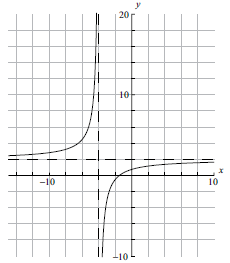 (A6)
(A6)
Notes: (A1) for labels and some idea of scale.
(A1) for \(x\)-intercept seen, (A1) for \(y\)-intercept seen in roughly the correct places (coordinates not required).
(A1) for vertical asymptote seen, (A1) for horizontal asymptote seen in roughly the correct places (equations of the lines not required).
(A1) for correct general shape.[6 marks]
\(x = – 4\) (A1)(A1)(ft)
Note: (A1) for \(x =\), (A1)(ft) for \( – 4\).[2 marks]
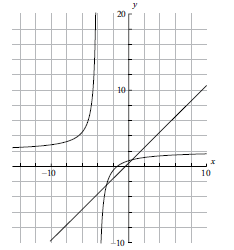 (A1)(A1)
(A1)(A1)
Note: (A1) for correct axis intercepts, (A1) for straight line[2 marks]
\(( – 2.85078{\text{, }} – 2.35078)\) OR \((0.35078{\text{, }}0.85078)\) (G1)(G1)(A1)(ft)
Notes: (A1) for \(x\)-coordinate, (A1) for \(y\)-coordinate, (A1)(ft) for correct accuracy. Brackets required. If brackets not used award (G1)(G0)(A1)(ft).
Accept \(x = – 2.85078\), \(y = – 2.35078\) or \(x = 0.35078\), \(y = 0.85078\).[3 marks]
\({\text{gradient}} = 1\) (A1)[1 mark]
\({\text{gradient of perpendicular}} = – 1\) (A1)(ft)
(can be implied in the next step)
\(y = mx + c\)
\( – 3 = – 1 \times – 2 + c\) (M1)
\(c = – 5\)
\(y = – x – 5\) (A1)(ft)(G2)
OR
\(y + 3 = – (x + 2)\) (M1)(A1)(ft)(G2)
Note: Award (G2) for correct answer with no working at all but (A1)(G1) if the gradient is mentioned as \( – 1\) then correct answer with no further working.[3 marks]
Question
Consider the curve \(y = {x^3} + \frac{3}{2}{x^2} – 6x – 2\) .
(i) Write down the value of \(y\) when \(x\) is \(2\).
(ii) Write down the coordinates of the point where the curve intercepts the \(y\)-axis.[3]
Sketch the curve for \( – 4 \leqslant x \leqslant 3\) and \( – 10 \leqslant y \leqslant 10\). Indicate clearly the information found in (a).[4]
Find \(\frac{{{\text{d}}y}}{{{\text{d}}x}}\) .[3]
Let \({L_1}\) be the tangent to the curve at \(x = 2\).
Let \({L_2}\) be a tangent to the curve, parallel to \({L_1}\).
(i) Show that the gradient of \({L_1}\) is \(12\).
(ii) Find the \(x\)-coordinate of the point at which \({L_2}\) and the curve meet.
(iii) Sketch and label \({L_1}\) and \({L_2}\) on the diagram drawn in (b).[8]
It is known that \(\frac{{{\text{d}}y}}{{{\text{d}}x}} > 0\) for \(x < – 2\) and \(x > b\) where \(b\) is positive.
(i) Using your graphic display calculator, or otherwise, find the value of \(b\).
(ii) Describe the behaviour of the curve in the interval \( – 2 < x < b\) .
(iii) Write down the equation of the tangent to the curve at \(x = – 2\).[5]
Answer/Explanation
Markscheme
(i) \(y = 0\) (A1)
(ii) \((0{\text{, }}{- 2})\) (A1)(A1)
Note: Award (A1)(A0) if brackets missing.
OR
\(x = 0{\text{, }}y = – 2\) (A1)(A1)
Note: If coordinates reversed award (A0)(A1)(ft). Two coordinates must be given.[3 marks]
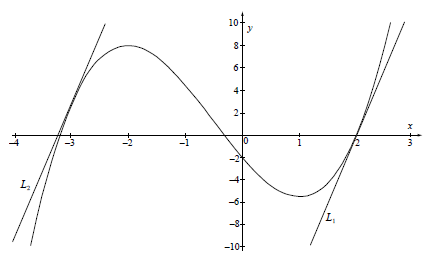 (A4)
(A4)
Notes: (A1) for appropriate window. Some indication of scale on the \(x\)-axis must be present (for example ticks). Labels not required. (A1) for smooth curve and shape, (A1) for maximum and minimum in approximately correct position, (A1) for \(x\) and \(y\) intercepts found in (a) in approximately correct position.[4 marks]
\(\frac{{{\text{d}}y}}{{{\text{d}}x}} = 3{x^2} + 3x – 6\) (A1)(A1)(A1)
Note: (A1) for each correct term. Award (A1)(A1)(A0) at most if any other term is present.[3 marks]
(i) \(3 \times 4 + 3 \times 2 – 6 = 12\) (M1)(A1)(AG)
Note: (M1) for using the derivative and substituting \(x = 2\) . (A1) for correct (and clear) substitution. The \(12\) must be seen.
(ii) Gradient of \({L_2}\) is \(12\) (can be implied) (A1)
\(3{x^2} + 3x – 6 = 12\) (M1)
\(x = – 3\) (A1)(G2)
Note: (M1) for equating the derivative to \(12\) or showing a sketch of the derivative together with a line at \(y = 12\) or a table of values showing the \(12\) in the derivative column.
(iii) (A1) for \({L_1}\) correctly drawn at approx the correct point (A1)
(A1) for \({L_2}\) correctly drawn at approx the correct point (A1)
(A1) for 2 parallel lines (A1)
Note: If lines are not labelled award at most (A1)(A1)(A0). Do not accept 2 horizontal or 2 vertical parallel lines.[8 marks]
(i) \(b = 1\) (G2)
(ii) The curve is decreasing. (A1)
Note: Accept any valid description.
(iii) \(y = 8\) (A1)(A1)(G2)
Note: (A1) for “\(y =\) a constant”, (A1) for \(8\).[5 marks]
Question
A function is defined by \(f(x) = \frac{5}{{{x^2}}} + 3x + c,{\text{ }}x \ne 0,{\text{ }}c \in \mathbb{Z}\).
Write down an expression for \(f ′(x)\).[4]
Consider the graph of f. The graph of f passes through the point P(1, 4).
Find the value of c.[2]
There is a local minimum at the point Q.
Find the coordinates of Q.[4]
There is a local minimum at the point Q.
Find the set of values of x for which the function is decreasing.[3]
Let T be the tangent to the graph of f at P.
Show that the gradient of T is –7.[2]
Let T be the tangent to the graph of f at P.
Find the equation of T.[2]
T intersects the graph again at R. Use your graphic display calculator to find the coordinates of R.[2]
Answer/Explanation
Markscheme
\(f'(x) = \frac{{ – 10}}{{{x^3}}} + 3\) (A1)(A1)(A1)(A1)
Note: Award (A1) for −10, (A1) for x3 (or x−3), (A1) for 3, (A1) for no other constant term.[4 marks]
4 = 5 + 3 + c (M1)
Note: Award (M1) for substitution in f (x).
c = −4 (A1)(G2)[2 marks]
\(f ‘(x) = 0\) (M1)
\(0 = \frac{{ – 10}}{{{x^3}}} + 3\) (A1)(ft)
(1.49, 2.72) (accept x = 1.49 y = 2.72) (A1)(ft)(A1)(ft)(G3)
Notes: If answer is given as (1.5, 2.7) award (A0)(AP)(A1).
Award at most (M1)(A1)(A1)(A0) if parentheses not included. (ft) from their (a).
If no working shown award (G2)(G0) if parentheses are not included.
OR
Award (M2) for sketch, (A1)(ft)(A1)(ft) for correct coordinates. (ft) from their (b). (M2)(A1)(ft)(A1)(ft)
Note: Award at most (M2)(A1)(ft)(A0) if parentheses not included.[4 marks]
0 < x < 1.49 OR 0 < x ≤ 1.49 (A1)(A1)(ft)(A1)
Notes: Award (A1) for 0, (A1)(ft) for 1.49 and (A1) for correct inequality signs.
(ft) from their x value in (c) (i).[3 marks]
For P(1, 4) \(f ‘(1) = – 10 + 3\) (M1)(A1)
\(= -7\) (AG)
Note: Award (M1) for substituting \(x = 1\) into their \(f ‘(x)\). (A1) for \(-10 + 3\).
\(-7\) must be seen for (A1) to be awarded.[2 marks]
\(4 = -7 \times 1 + c\) \(11 = c\) (A1)
\(y = -7 x + 11\) (A1)[2 marks]
Point of intersection is R(−0.5, 14.5) (A1)(ft)(A1)(ft)(G2)(ft)
Notes: Award (A1) for the x coordinate, (A1) for the y coordinate.
Allow (ft) from candidate’s (d)(ii) equation and their (b) even with no working seen.
Award (A1)(ft)(A0) if brackets not included and not previously penalised.[2 marks]
Question
The diagram shows a sketch of the function f (x) = 4x3 − 9x2 − 12x + 3.
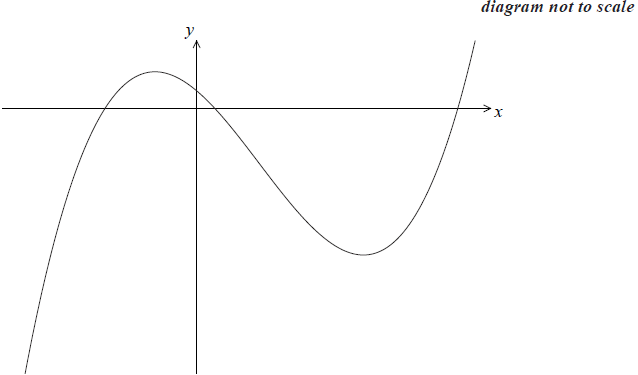
Write down the values of x where the graph of f (x) intersects the x-axis.[3]
Write down f ′(x).[3]
Find the value of the local maximum of y = f (x).[4]
Let P be the point where the graph of f (x) intersects the y axis.
Write down the coordinates of P.[1]
Let P be the point where the graph of f (x) intersects the y axis.
Find the gradient of the curve at P.[2]
The line, L, is the tangent to the graph of f (x) at P.
Find the equation of L in the form y = mx + c.[2]
There is a second point, Q, on the curve at which the tangent to f (x) is parallel to L.
Write down the gradient of the tangent at Q.[1]
There is a second point, Q, on the curve at which the tangent to f (x) is parallel to L.
Calculate the x-coordinate of Q.[3]
Answer/Explanation
Markscheme
–1.10, 0.218, 3.13 (A1)(A1)(A1)[3 marks]
f ′(x) = 12x2 – 18x – 12 (A1)(A1)(A1)
Note: Award (A1) for each correct term and award maximum of (A1)(A1) if other terms seen.[3 marks]
f ′(x) = 0 (M1)
x = –0.5, 2
x = –0.5 (A1)
Note: If x = –0.5 not stated, can be inferred from working below.
y = 4(–0.5)3 – 9(–0.5)2 – 12(–0.5) + 3 (M1)
y = 6.25 (A1)(G3)
Note: Award (M1) for their value of x substituted into f (x).
Award (M1)(G2) if sketch shown as method. If coordinate pair given then award (M1)(A1)(M1)(A0). If coordinate pair given with no working award (G2).[4 marks]
(0, 3) (A1)
Note: Accept x = 0, y = 3.[1 mark]
f ′(0) = –12 (M1)(A1)(ft)(G2)
Note: Award (M1) for substituting x = 0 into their derivative.[2 marks]
Tangent: y = –12x + 3 (A1)(ft)(A1)(G2)
Note: Award (A1)(ft) for their gradient, (A1) for intercept = 3.
Award (A1)(A0) if y = not seen.[2 marks]
–12 (A1)(ft)
Note: Follow through from their part (e).[1 mark]
12x2 – 18x – 12 = –12 (M1)
12x2 – 18x = 0 (M1)
x = 1.5, 0
At Q x = 1.5 (A1)(ft)(G2)
Note: Award (M1)(G2) for 12x2 – 18x – 12 = –12 followed by x = 1.5.
Follow through from their part (g).[3 marks]
Question
Consider the function f (x) = x3 – 3x– 24x + 30.
Write down f (0).[1]
Find \(f'(x)\).[3]
Find the gradient of the graph of f (x) at the point where x = 1.[2]
(i) Use f ‘(x) to find the x-coordinate of M and of N.
(ii) Hence or otherwise write down the coordinates of M and of N.[5]
Sketch the graph of f (x) for \( – 5 \leqslant x \leqslant 7\) and \( – 60 \leqslant y \leqslant 60\). Mark clearly M and N on your graph.[4]
Lines L1 and L2 are parallel, and they are tangents to the graph of f (x) at points A and B respectively. L1 has equation y = 21x + 111.
(i) Find the x-coordinate of A and of B.
(ii) Find the y-coordinate of B.[6]
Answer/Explanation
Markscheme
30 (A1)[1 mark]
f ‘(x) = 3x2 – 6x – 24 (A1)(A1)(A1)
Note: Award (A1) for each term. Award at most (A1)(A1) if extra terms present.[3 marks]
f ‘(1) = –27 (M1)(A1)(ft)(G2)
Note: Award (M1) for substituting x = 1 into their derivative.[2 marks]
(i) f ‘(x) = 0
3x2 – 6x – 24 = 0 (M1)
x = 4; x = –2 (A1)(ft)(A1)(ft)
Notes: Award (M1) for either f ‘(x) = 0 or 3x2 – 6x – 24 = 0 seen. Follow through from their derivative. Do not award the two answer marks if derivative not used.
(ii) M(–2, 58) accept x = –2, y = 58 (A1)(ft)
N(4, – 50) accept x = 4, y = –50 (A1)(ft)
Note: Follow through from their answer to part (d) (i).[5 marks]
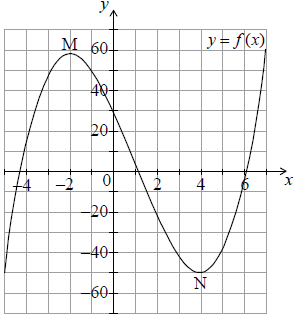
(A1) for window
(A1) for a smooth curve with the correct shape
(A1) for axes intercepts in approximately the correct positions
(A1) for M and N marked on diagram and in approximately
correct position (A4)
Note: If window is not indicated award at most (A0)(A1)(A0)(A1)(ft).[4 marks]
(i) 3x2 – 6x – 24 = 21 (M1)
3x2 – 6x – 45 = 0 (M1)
x = 5; x = –3 (A1)(ft)(A1)(ft)(G3)
Note: Follow through from their derivative.
OR
Award (A1) for L1 drawn tangent to the graph of f on their sketch in approximately the correct position (x = –3), (A1) for a second tangent parallel to their L1, (A1) for x = –3, (A1) for x = 5 . (A1)(ft)(A1)(ft)(A1)(A1)
Note: If only x = –3 is shown without working award (G2). If both answers are shown irrespective of workingaward (G3).
(ii) f (5) = –40 (M1)(A1)(ft)(G2)
Notes: Award (M1) for attempting to find the image of their x = 5. Award (A1) only for (5, –40). Follow through from their x-coordinate of B only if it has been clearly identified in (f) (i).[6 marks]
Question
Consider the function \(f(x) = {x^3} + \frac{{48}}{x}{\text{, }}x \ne 0\).
Calculate \(f(2)\) .[2]
Sketch the graph of the function \(y = f(x)\) for \( – 5 \leqslant x \leqslant 5\) and \( – 200 \leqslant y \leqslant 200\) .[4]
Find \(f'(x)\) .[3]
Find \(f'(2)\) .[2]
Write down the coordinates of the local maximum point on the graph of \(f\) .[2]
Find the gradient of the tangent to the graph of \(f\) at \(x = 1\).[2]
There is a second point on the graph of \(f\) at which the tangent is parallel to the tangent at \(x = 1\).
Find the \(x\)-coordinate of this point.[2]
Answer/Explanation
Markscheme
\(f(2) = {2^3} + \frac{{48}}{2}\) (M1)
\(= 32\) (A1)(G2)[2 marks]
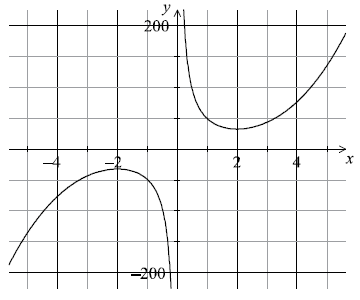
(A1) for labels and some indication of scale in an appropriate window
(A1) for correct shape of the two unconnected and smooth branches
(A1) for maximum and minimum in approximately correct positions
(A1) for asymptotic behaviour at \(y\)-axis (A4)
Notes: Please be rigorous.
The axes need not be drawn with a ruler.
The branches must be smooth: a single continuous line that does not deviate from its proper direction.
The position of the maximum and minimum points must be symmetrical about the origin.
The \(y\)-axis must be an asymptote for both branches. Neither branch should touch the axis nor must the curve approach the
asymptote then deviate away later.[4 marks]
\(f'(x) = 3{x^2} – \frac{{48}}{{{x^2}}}\) (A1)(A1)(A1)
Notes: Award (A1) for \(3{x^2}\) , (A1) for \( – 48\) , (A1) for \({x^{ – 2}}\) . Award a maximum of (A1)(A1)(A0) if extra terms seen.[3 marks]
\(f'(2) = 3{(2)^2} – \frac{{48}}{{{{(2)}^2}}}\) (M1)
Note: Award (M1) for substitution of \(x = 2\) into their derivative.
\(= 0\) (A1)(ft)(G1)[2 marks]
\(( – 2{\text{, }} – 32)\) or \(x = – 2\), \(y = – 32\) (G1)(G1)
Notes: Award (G0)(G0) for \(x = – 32\), \(y = – 2\) . Award at most (G0)(G1) if parentheses are omitted.[2 marks]
\(\{ y \geqslant 32\} \cup \{ y \leqslant – 32\} \) (A1)(A1)(ft)(A1)(ft)
Notes: Award (A1)(ft) \(y \geqslant 32\) or \(y > 32\) seen, (A1)(ft) for \(y \leqslant – 32\) or \(y < – 32\) , (A1) for weak (non-strict) inequalities used in both of the above.
Accept use of \(f\) in place of \(y\). Accept alternative interval notation.
Follow through from their (a) and (e).
If domain is given award (A0)(A0)(A0).
Award (A0)(A1)(ft)(A1)(ft) for \([ – 200{\text{, }} – 32]\) , \([32{\text{, }}200]\).
Award (A0)(A1)(ft)(A1)(ft) for \(] – 200{\text{, }} – 32]\) , \([32{\text{, }}200[\).[3 marks]
\(f'(1) = – 45\) (M1)(A1)(ft)(G2)
Notes: Award (M1) for \(f'(1)\) seen or substitution of \(x = 1\) into their derivative. Follow through from their derivative if working is seen.[2 marks]
\(x = – 1\) (M1)(A1)(ft)(G2)
Notes: Award (M1) for equating their derivative to their \( – 45\) or for seeing parallel lines on their graph in the approximately correct position.[2 marks]
Question
The function \(f(x)\) is defined by \(f(x) = 1.5x + 4 + \frac{6}{x}{\text{, }}x \ne 0\) .
Write down the equation of the vertical asymptote.[2]
Find \(f'(x)\) .[3]
Find the gradient of the graph of the function at \(x = – 1\).[2]
Using your answer to part (c), decide whether the function \(f(x)\) is increasing or decreasing at \(x = – 1\). Justify your answer.[2]
Sketch the graph of \(f(x)\) for \( – 10 \leqslant x \leqslant 10\) and \( – 20 \leqslant y \leqslant 20\) .[4]
\({{\text{P}}_1}\) is the local maximum point and \({{\text{P}}_2}\) is the local minimum point on the graph of \(f(x)\) .
Using your graphic display calculator, write down the coordinates of
(i) \({{\text{P}}_1}\) ;
(ii) \({{\text{P}}_2}\) .[4]
Using your sketch from (e), determine the range of the function \(f(x)\) for \( – 10 \leqslant x \leqslant 10\) .[3]
Answer/Explanation
Markscheme
\(x = 0\) (A1)(A1)
Note: Award (A1) for \(x = {\text{constant}}\), (A1) for \(0\).[2 marks]
\(f'(x) = 1.5 – \frac{6}{{{x^2}}}\) (A1)(A1)(A1)
Notes: Award (A1) for \(1.5\), (A1) for \( – 6\), (A1) for \({x^{ – 2}}\) . Award (A1)(A1)(A0) at most if any other term present.[3 marks]
\(1.5 – \frac{6}{{( – 1)}}\) (M1)
\( = – 4.5\) (A1)(ft)(G2)
Note: Follow through from their derivative function.[2 marks]
Decreasing, the derivative (gradient or slope) is negative (at \(x = – 1\)) (A1)(R1)(ft)
Notes: Do not award (A1)(R0). Follow through from their answer to part (c).[2 marks]
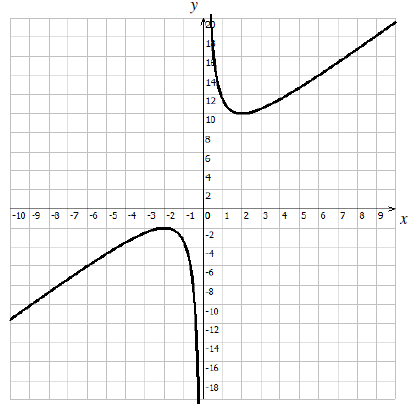 (A4)
(A4)
Notes: Award (A1) for labels and some indication of scales and an appropriate window.
Award (A1) for correct shape of the two unconnected, and smooth branches.
Award (A1) for the maximum and minimum points in the approximately correct positions.
Award (A1) for correct asymptotic behaviour at \(x = 0\) .
Notes: Please be rigorous.
The axes need not be drawn with a ruler.
The branches must be smooth and single continuous lines that do not deviate from their proper direction.
The max and min points must be symmetrical about point \((0{\text{, }}4)\) .
The \(y\)-axis must be an asymptote for both branches.[4 marks]
(i) \(( – 2{\text{, }} – 2)\) or \(x = – 2\), \(y = – 2\) (G1)(G1)
(ii) \((2{\text{, }}10)\) or \(x = 2\), \(y = 10\) (G1)(G1)[4 marks]
\(\{ – 2 \geqslant y\} \) or \(\{ y \geqslant 10\} \) (A1)(A1)(ft)(A1)
Notes: (A1)(ft) for \(y > 10\) or \(y \geqslant 10\) . (A1)(ft) for \(y < – 2\) or \(y \leqslant – 2\) . (A1) for weak (non-strict) inequalities used in both of the above. Follow through from their (e) and (f).[3 marks]
Question
The diagram shows part of the graph of \(f(x) = {x^2} – 2x + \frac{9}{x}\) , where \(x \ne 0\) .
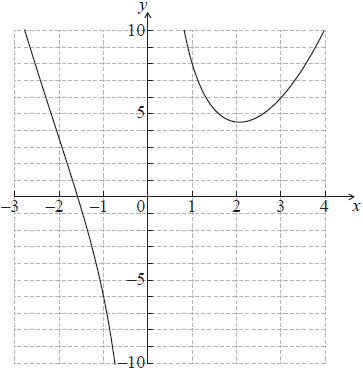
Write down
(i) the equation of the vertical asymptote to the graph of \(y = f (x)\) ;
(ii) the solution to the equation \(f (x) = 0\) ;
(iii) the coordinates of the local minimum point.[5]
Find \(f'(x)\) .[4]
Show that \(f'(x)\) can be written as \(f'(x) = \frac{{2{x^3} – 2{x^2} – 9}}{{{x^2}}}\) .[2]
Find the gradient of the tangent to \(y = f (x)\) at the point \({\text{A}}(1{\text{, }}8)\) .[2]
The line, \(L\), passes through the point A and is perpendicular to the tangent at A.
Write down the gradient of \(L\) .[1]
The line, \(L\) , passes through the point A and is perpendicular to the tangent at A.
Find the equation of \(L\) . Give your answer in the form \(y = mx + c\) .[3]
The line, \(L\) , passes through the point A and is perpendicular to the tangent at A.
\(L\) also intersects the graph of \(y = f (x)\) at points B and C . Write down the x-coordinate of B and of C .[2]
Answer/Explanation
Markscheme
(i) \(x = 0\) (A1)(A1)
Note: Award (A1) for \(x = \) a constant, (A1) for the constant in their equation being \(0\).
(ii) \( – 1.58\) (\( – 1.58454 \ldots \)) (G1)
Note: Accept \( – 1.6\), do not accept \( – 2\) or \( – 1.59\).
(iii) \((2.06{\text{, }}4.49)\) \((2.06020 \ldots {\text{, }}4.49253 \ldots )\) (G1)(G1)
Note: Award at most (G1)(G0) if brackets not used. Award (G0)(G1)(ft) if coordinates are reversed.
Note: Accept \(x = 2.06\), \(y = 4.49\) .
Note: Accept \(2.1\), do not accept \(2.0\) or \(2\). Accept \(4.5\), do not accept \(5\) or \(4.50\).[5 marks]
\(f'(x) = 2x – 2 – \frac{9}{{{x^2}}}\) (A1)(A1)(A1)(A1)
Notes: Award (A1) for \(2x\), (A1) for \( – 2\), (A1) for \( – 9\), (A1) for \({x^{ – 2}}\) . Award a maximum of (A1)(A1)(A1)(A0) if there are extra terms present.[4 marks]
\(f'(x) = \frac{{{x^2}(2x – 2)}}{{{x^2}}} – \frac{9}{{{x^2}}}\) (M1)
Note: Award (M1) for taking the correct common denominator.
\( = \frac{{(2{x^3} – 2{x^2})}}{{{x^2}}} – \frac{9}{{{x^2}}}\) (M1)
Note: Award (M1) for multiplying brackets or equivalent.
\( = \frac{{2{x^3} – 2{x^2} – 9}}{{{x^2}}}\) (AG)
Note: The final (M1) is not awarded if the given answer is not seen.[2 marks]
\(f'(1) = \frac{{2{{(1)}^3} – 2(1) – 9}}{{{{(1)}^2}}}\) (M1)
\( = – 9\) (A1)(G2)
Note: Award (M1) for substitution into given (or their correct) \(f'(x)\) . There is no follow through for use of their incorrect derivative.[2 marks]
\(\frac{1}{9}\) (A1)(ft)
Note: Follow through from part (d).[1 mark]
\(y – 8 = \frac{1}{9}(x – 1)\) (M1)(M1)
Notes: Award (M1) for substitution of their gradient from (e), (M1) for substitution of given point. Accept all forms of straight line.
\(y = \frac{1}{9}x + \frac{{71}}{9}\) (\(y = 0.111111 \ldots x + 7.88888 \ldots \)) (A1)(ft)(G3)
Note: Award the final (A1)(ft) for a correctly rearranged formula of their straight line in (f). Accept \(0.11x\), do not accept \(0.1x\). Accept \(7.9\), do not accept \(7.88\), do not accept \(7.8\).[3 marks]
\( – 2.50\), \(3.61\) (\( – 2.49545 \ldots \), \(3.60656 \ldots \)) (A1)(ft)(A1)(ft)
Notes: Follow through from their line \(L\) from part (f) even if no working shown. Award at most (A0)(A1)(ft) if their correct coordinate pairs given.
Note: Accept \( – 2.5\), do not accept \( – 2.49\). Accept \(3.6\), do not accept \(3.60\).[2 marks]
Question
Consider the function \(f(x) = – \frac{1}{3}{x^3} + \frac{5}{3}{x^2} – x – 3\).
Sketch the graph of y = f (x) for −3 ≤ x ≤ 6 and −10 ≤ y ≤ 10 showing clearly the axes intercepts and local maximum and minimum points. Use a scale of 2 cm to represent 1 unit on the x-axis, and a scale of 1 cm to represent 1 unit on the y-axis.[4]
Find the value of f (−1).[2]
Write down the coordinates of the y-intercept of the graph of f (x).[1]
Find f ‘(x).[3]
Show that \(f'( – 1) = – \frac{{16}}{3}\).[1]
Explain what f ‘(−1) represents.[2]
Find the equation of the tangent to the graph of f (x) at the point where x is –1.[2]
Sketch the tangent to the graph of f (x) at x = −1 on your diagram for (a).[2]
P and Q are points on the curve such that the tangents to the curve at these points are horizontal. The x-coordinate of P is a, and the x-coordinate of Q is b, b > a.
Write down the value of
(i) a ;
(ii) b .[2]
P and Q are points on the curve such that the tangents to the curve at these points are horizontal. The x-coordinate of P is a, and the x-coordinate of Q is b, b > a.
Describe the behaviour of f (x) for a < x < b.[1]
Answer/Explanation
Markscheme
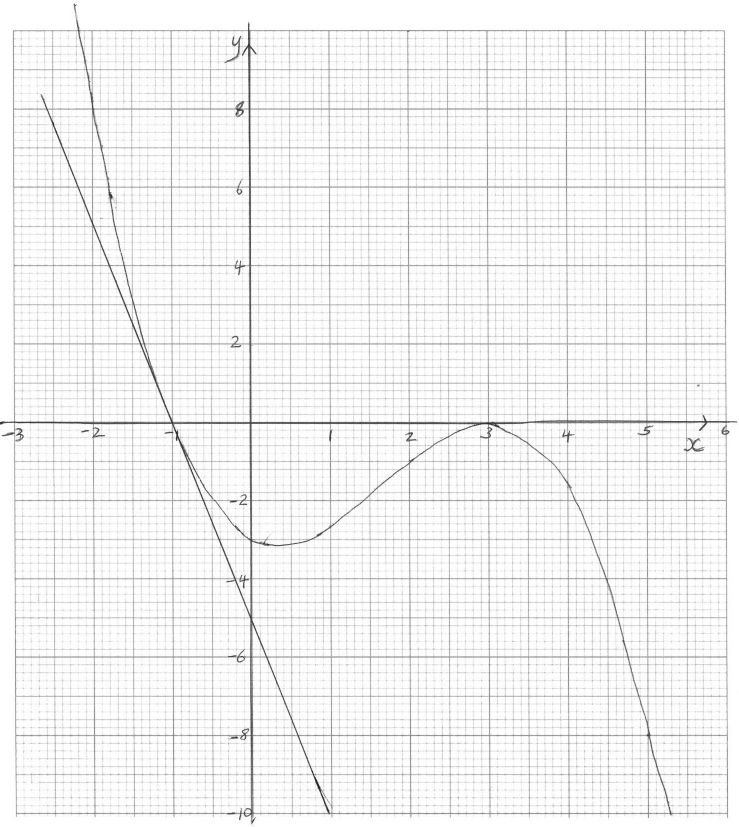
(A1) for indication of window and labels. (A1) for smooth curve that does not enter the first quadrant, the curve must consist of one line only.
(A1) for x and y intercepts in approximately correct positions (allow ±0.5).
(A1) for local maximum and minimum in approximately correct position. (minimum should be 0 ≤ x ≤ 1 and –2 ≤ y ≤ –4 ), the y-coordinate of the maximum should be 0 ± 0.5. (A4)[4 marks]
\(-\frac{1}{3}(-1)^3 + \frac{5}{3}(-1)^2 – (-1) – 3 \) (M1)
Note: Award (M1) for substitution of –1 into f (x)
= 0 (A1)(G2)[2 marks]
(0, –3) (A1)
OR
x = 0, y = –3 (A1)
Note: Award (A0) if brackets are omitted.[1 mark]
\(f'(x) = – {x^2} + \frac{{10}}{3}x – 1\) (A1)(A1)(A1)
Note: Award (A1) for each correct term. Award (A1)(A1)(A0) at most if there are extra terms.[3 marks]
\(f'( – 1) = – {( – 1)^2} + \frac{{10}}{3}( – 1) – 1\) (M1)
\(= -\frac{16}{3}\) (AG)
Note: Award (M1) for substitution of x = –1 into correct derivative only. The final answer must be seen.[1 mark]
f ‘(–1) gives the gradient of the tangent to the curve at the point with x = –1. (A1)(A1)
Note: Award (A1) for “gradient (of curve)”, (A1) for “at the point with x = –1”. Accept “the instantaneous rate of change of y” or “the (first) derivative”.[2 marks]
\(y = – \frac{16}{3} x + c\) (M1)
Note: Award (M1) for \(-\frac{16}{3}\) substituted in equation.
\(0 = – \frac{16}{3} \times (-1) + c \)
\(c = – \frac{16}{3}\)
\(y = – \frac{{16}}{3}x – \frac{{16}}{3}\) (A1)(G2)
Note: Accept y = –5.33x – 5.33.
OR
\((y – 0) = \frac{{-16}}{3}(x + 1)\) (M1)(A1)(G2)
Note: Award (M1) for \( – \frac{{16}}{3}\) substituted in equation, (A1) for correct equation. Follow through from their answer to part (b). Accept y = –5.33 (x +1). Accept equivalent equations.[2 marks]
(A1)(ft) for a tangent to their curve drawn.
(A1)(ft) for their tangent drawn at the point x = –1. (A1)(ft)(A1)(ft)
Note: Follow through from their graph. The tangent must be a straight line otherwise award at most (A0)(A1).[2 marks]
(i) \(a = \frac{1}{3}\) (G1)
(ii) \(b = 3\) (G1)
Note: If a and b are reversed award (A0)(A1).[2 marks]
f (x) is increasing (A1)[1 mark]
Question
Consider the function \(g(x) = bx – 3 + \frac{1}{{{x^2}}},{\text{ }}x \ne 0\).
Write down the equation of the vertical asymptote of the graph of y = g(x) .[2]
Write down g′(x) .[3]
The line T is the tangent to the graph of y = g(x) at the point where x = 1. The gradient of T is 3.
Show that b = 5.[2]
The line T is the tangent to the graph of y = g(x) at the point where x = 1. The gradient of T is 3.
Find the equation of T.[3]
Using your graphic display calculator find the coordinates of the point where the graph of y = g(x) intersects the x-axis.[2]
(i) Sketch the graph of y = g(x) for −2 ≤ x ≤ 5 and −15 ≤ y ≤ 25, indicating clearly your answer to part (e).
(ii) Draw the line T on your sketch.[6]
Using your graphic display calculator find the coordinates of the local minimum point of y = g(x) .[2]
Write down the interval for which g(x) is increasing in the domain 0 < x < 5 .[2]
Answer/Explanation
Markscheme
x = 0 (A1)(A1)
Notes: Award (A1) for x=constant, (A1) for 0. Award (A0)(A0) if answer is not an equation.[2 marks]
\(b – \frac{2}{{{x^3}}}\) (A1)(A1)(A1)
Note: Award (A1) for b, (A1) for −2, (A1) for \(\frac{1}{{{x^3}}}\) (or x−3). Award at most (A1)(A1)(A0) if extra terms seen.[3 marks]
\(3 = b – \frac{2}{{{{(1)}^3}}}\) (M1)(M1)
Note: Award (M1) for substituting 1 into their gradient function, (M1) for equating their gradient function to 3.
b = 5 (AG)
Note: Award at most (M1)(A0) if final line is not seen or b does not equal 5.[2 marks]
g(1) = 3 or (1, 3) (seen or implied from the line below) (A1)
3 = 3 × 1 + c (M1)
Note: Award (M1) for correct substitution of their point (1, 3) and gradient 3 into equation y = mx + c. Follow through from their point of tangency.
y = 3x (A1)(ft)(G2)
OR
y − 3 = 3(x − 1) (M1)(A1)(ft)(G2)
Note: Award (M1) for substitution of gradient 3 and their point (1, 3) into y − y1 = m(x − x1), (A1)(ft) for correct substitutions. Follow through from their point of tangency. Award at most (A1)(M1)(A0)(ft) if further incorrect working seen.[3 marks]
(−0.439, 0) ((−0.438785…, 0)) (G1)(G1)
Notes: If no parentheses award at most (G1)(G0). Accept x = 0.439, y = 0.[2 marks]
(i)
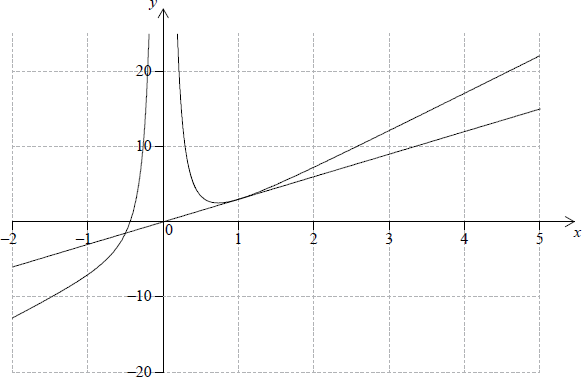
Award (A1) for labels and some indication of scale in the stated window.
Award (A1) for correct general shape (curve must be smooth and must not cross the y-axis)
Award (A1)(ft) for x-intercept consistent with their part (e).
Award (A1) for local minimum in the first quadrant. (A1)(A1)(A1)(ft)(A1)
(ii) Tangent to curve drawn at approximately x = 1 (A1)(A1)
Note: Award (A1) for a line tangent to curve approximately at x = 1. Must be a straight line for the mark to be awarded. Award (A1)(ft) for line passing through the origin. Follow through from their answer to part (d).[6 marks]
(0.737, 2.53) ((0.736806…, 2.52604…)) (G1)(G1)
Notes: Do not penalize for lack of parentheses if already penalized in (e). Accept x = 0.737, y = 2.53.[2 marks]
0.737 < x < 5 OR (0.737;5) (A1)(A1)(ft)
Notes: Award (A1) for correct strict or weak inequalities with x seen if the interval is given as inequalities, (A1)(ft) for 0.737 and 5 or their value from part (g).[2 marks]
Question
The graph of the function \(f(x) = \frac{{14}}{x} + x – 6\), for 1 ≤ x ≤ 7 is given below.
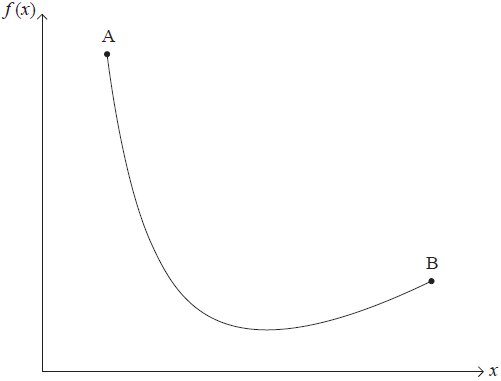
Calculate \(f (1)\).[2]
Find \(f ′(x)\).[3]
Use your answer to part (b) to show that the x-coordinate of the local minimum point of the graph of \(f\) is 3.7 correct to 2 significant figures.[3]
Find the range of \(f\).[3]
Points A and B lie on the graph of \(f\). The x-coordinates of A and B are 1 and 7 respectively.
Write down the y-coordinate of B.[1]
Points A and B lie on the graph of f . The x-coordinates of A and B are 1 and 7 respectively.
Find the gradient of the straight line passing through A and B.[2]
M is the midpoint of the line segment AB.
Write down the coordinates of M.[2]
L is the tangent to the graph of the function \(y = f (x)\), at the point on the graph with the same x-coordinate as M.
Find the gradient of L.[2]
Find the equation of L. Give your answer in the form \(y = mx + c\).[3]
Answer/Explanation
Markscheme
\(\frac{{14}}{{(1)}} + (1) – 6\) (M1)
Note: Award (M1) for substituting \(x = 1\) into \(f\).
\(= 9\) (A1)(G2)
\( – \frac{{14}}{{{x^2}}} + 1\) (A3)
Note: Award (A1) for \(-14\), (A1) for \(\frac{{14}}{{{x^2}}}\) or for \(x^{-2}\), (A1) for \(1\).
Award at most (A2) if any extra terms are present.
\( – \frac{{14}}{{{x^2}}} + 1 = 0\) or \(f ‘ (x) = 0 \) (M1)
Note: Award (M1) for equating their derivative in part (b) to 0.
\(\frac{{14}}{{{x^2}}} = 1\) or \({x^2} = 14\) or equivalent (M1)
Note: Award (M1) for correct rearrangement of their equation.
\(x = 3.74165…(\sqrt {14})\) (A1)
\(x = 3.7\) (AG)
Notes: Both the unrounded and rounded answers must be seen to award the (A1). This is a “show that” question; appeals to their GDC are not accepted –award a maximum of (M1)(M0)(A0).
Specifically, \( – \frac{{14}}{{{x^2}}} + 1 = 0\) followed by \(x = 3.74165…, x = 3.7\) is awarded (M1)(M0)(A0).
\(1.48 \leqslant y \leqslant 9\) (A1)(A1)(ft)(A1)
Note: Accept alternative notations, for example [1.48,9]. (\(x = \sqrt{14}\) leads to answer 1.48331…)
Note: Award (A1) for 1.48331…seen, accept 1.48378… from using the given answer \(x = 3.7\), (A1)(ft) for their 9 from part (a) seen, (A1) for the correct notation for their interval (accept \( \leqslant y \leqslant \) or \( \leqslant f \leqslant \) ).
3 (A1)
Note: Do not accept a coordinate pair.
\(\frac{{3 – 9}}{{7 – 1}}\) (M1)
Note: Award (M1) for their correct substitution into the gradient formula.
\(= -1\) (A1)(ft)(G2)
Note: Follow through from their answers to parts (a) and (e).
(4, 6) (A1)(ft)(A1)
Note: Accept \(x = 4\), \(y = 6\). Award at most (A1)(A0) if parentheses not seen.
If coordinates reversed award (A0)(A1)(ft).
Follow through from their answers to parts (a) and (e).
\( – \frac{{14}}{{{4^2}}} + 1\) (M1)
Note: Award (M1) for substitution into their gradient function.
Follow through from their answers to parts (b) and (g).
\( = \frac{1}{8}(0.125)\) (A1)(ft)(G2)
\(y – 1.5 = \frac{1}{8}(x – 4)\) (M1)(ft)(M1)
Note: Award (M1) for substituting their (4, 1.5) in any straight line formula,
(M1) for substituting their gradient in any straight line formula.
\(y = \frac{x}{8} + 4\) (A1)(ft)(G2)
Note: The form of the line has been specified in the question.
Question
Consider the function \(f(x) = \frac{3}{4}{x^4} – {x^3} – 9{x^2} + 20\).
Find \(f( – 2)\).[2]
Find \(f'(x)\).[3]
The graph of the function \(f(x)\) has a local minimum at the point where \(x = – 2\).
Using your answer to part (b), show that there is a second local minimum at \(x = 3\).[5]
The graph of the function \(f(x)\) has a local minimum at the point where \(x = – 2\).
Sketch the graph of the function \(f(x)\) for \( – 5 \leqslant x \leqslant 5\) and \( – 40 \leqslant y \leqslant 50\). Indicate on your
sketch the coordinates of the \(y\)-intercept.[4]
The graph of the function \(f(x)\) has a local minimum at the point where \(x = – 2\).
Write down the coordinates of the local maximum.[2]
Let \(T\) be the tangent to the graph of the function \(f(x)\) at the point \((2, –12)\).
Find the gradient of \(T\).[2]
The line \(L\) passes through the point \((2, −12)\) and is perpendicular to \(T\).
\(L\) has equation \(x + by + c = 0\), where \(b\) and \(c \in \mathbb{Z}\).
Find
(i) the gradient of \(L\);
(ii) the value of \(b\) and the value of \(c\).[5]
Answer/Explanation
Markscheme
\(\frac{3}{4}{( – 2)^4} – {( – 2)^3} – 9{( – 2)^2} + 20\) (M1)
Note: Award (M1) for substituting \(x = – 2\) in the function.
\(= 4\) (A1)(G2)
Note: If the coordinates \(( – 2,{\text{ }}4)\) are given as the answer award, at most, (M1)(A0). If no working shown award (G1).
If \(x = – 2,{\text{ }}y = 4\) seen then award full marks.[2 marks]
\(3{x^3} – 3{x^2} – 18x\) (A1)(A1)(A1)
Note: Award (A1) for each correct term, award at most (A1)(A1)(A0) if extra terms seen.[3 marks]
\(f'(3) = 3 \times {(3)^3} – 3 \times {(3)^2} – 18 \times 3\) (M1)
Note: Award (M1) for substitution in their \(f'(x)\) of \(x = 3\).
\( = 0\) (A1)
OR
\(3{x^3} – 3{x^2} – 18x = 0\) (M1)
Note: Award (M1) for equating their \(f'(x)\) to zero.
\(x = 3\) (A1)
\(f'({x_1}) = 3 \times {({x_1})^3} – 3 \times {({x_1})^2} – 18 \times {x_1} < 0\) where \(0 < {x_1} < 3\) (M1)
Note: Award (M1) for substituting a value of \({x_1}\) in the range \(0 < {x_1} < 3\) into their \(f’\) and showing it is negative (decreasing).
\(f'({x_2}) = 3 \times {({x_2})^3} – 3 \times {({x_2})^2} – 18 \times {x_2} > 0\) where \({x_2} > 3\) (M1)
Note: Award (M1) for substituting a value of \({x_2}\) in the range \({x_2} > 3\) into their \(f’\) and showing it is positive (increasing).
OR
With or without a sketch:
Showing \(f({x_1}) > f(3)\) where \({x_1} < 3\) and \({x_1}\) is close to 3. (M1)
Showing \(f({x_2}) > f(3)\) where \({x_2} > 3\) and \({x_2}\) is close to 3. (M1)
Note: If a sketch of \(f(x)\) is drawn in this part of the question and \(x = 3\) is identified as a stationary point on the curve, then
(i) award, at most, (M1)(A1)(M1)(M0) if the stationary point has been found;
(ii) award, at most, (M0)(A0)(M1)(M0) if the stationary point has not been previously found.
Since the gradients go from negative (decreasing) through zero to positive (increasing) it is a local minimum (R1)(AG)
Note: Only award (R1) if the first two marks have been awarded ie \(f'(3)\) has been shown to be equal to \(0\).[5 marks]
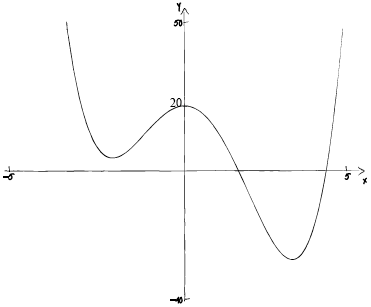 (A1)(A1)(A1)(A1)
(A1)(A1)(A1)(A1)
Notes: Award (A1) for labelled axes and indication of scale on both axes.
Award (A1) for smooth curve with correct shape.
Award (A1) for local minima in \({2^{{\text{nd}}}}\) and \({4^{{\text{th}}}}\) quadrants.
Award (A1) for y intercept \((0, 20)\) seen and labelled. Accept \(20\) on \(y\)–axis.
Do not award the third (A1) mark if there is a turning point on the \(x\)-axis.
If the derivative function is sketched then award, at most, (A1)(A0)(A0)(A0).
For a smooth curve (with correct shape) there should be ONE continuous thin line, no part of which is straight and no (one to many) mappings of \(x\).[4 marks]
\((0, 20)\) (G1)(G1)
Note: If parentheses are omitted award (G0)(G1).
OR
\(x = 0,{\text{ }}y = 20\) (G1)(G1)
Note: If the derivative function is sketched in part (d), award (G1)(ft)(G1)(ft) for \((–1.12, 12.2)\).[2 marks]
\(f'(2) = 3{(2)^3} – 3{(2)^2} – 18(2)\) (M1)
Notes: Award (M1) for substituting \(x = 2\) into their \(f'(x)\).
\( = – 24\) (A1)(ft)(G2)[2 marks]
(i) Gradient of perpendicular \( = \frac{1}{{24}}\) \((0.0417, 0.041666…)\) (A1)(ft)(G1
Note: Follow through from part (f).
(ii) \(y + 12 = \frac{1}{{24}}(x – 2)\) (M1)(M1)
Note: Award (M1) for correct substitution of \((2, –12)\), (M1) for correct substitution of their perpendicular gradient into equation of line.
OR
\( – 12 = \frac{1}{{24}} \times 2 + d\) (M1)
\(d = – \frac{{145}}{{12}}\)
\(y = \frac{1}{{24}}x – \frac{{145}}{{12}}\) (M1)
Note: Award (M1) for correct substitution of \((2, –12)\) and gradient into equation of a straight line, (M1) for correct substitution of the perpendicular gradient and correct substitution of \(d\)into equation of line.
\(b = – 24,{\text{ }}c = – 290\) (A1)(ft)(A1)(ft)(G3)
Note: Follow through from parts (f) and g(i).
To award (ft) marks, \(b\) and \(c\) must be integers.
Where candidate has used \(0.042\) from g(i), award (A1)(ft) for \(–288\).[5 marks]
Question
A parcel is in the shape of a rectangular prism, as shown in the diagram. It has a length \(l\) cm, width \(w\) cm and height of \(20\) cm.
The total volume of the parcel is \(3000{\text{ c}}{{\text{m}}^3}\).
Express the volume of the parcel in terms of \(l\) and \(w\).[1]
Show that \(l = \frac{{150}}{w}\).[2]
The parcel is tied up using a length of string that fits exactly around the parcel, as shown in the following diagram.
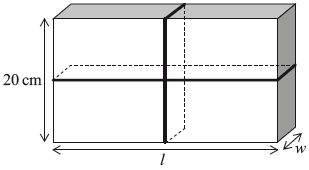
Show that the length of string, \(S\) cm, required to tie up the parcel can be written as
\[S = 40 + 4w + \frac{{300}}{w},{\text{ }}0 < w \leqslant 20.\][2]
The parcel is tied up using a length of string that fits exactly around the parcel, as shown in the following diagram.

Draw the graph of \(S\) for \(0 < w \leqslant 20\) and \(0 < S \leqslant 500\), clearly showing the local minimum point. Use a scale of \(2\) cm to represent \(5\) units on the horizontal axis \(w\) (cm), and a scale of \(2\) cm to represent \(100\) units on the vertical axis \(S\) (cm).[2]
The parcel is tied up using a length of string that fits exactly around the parcel, as shown in the following diagram.

Find \(\frac{{{\text{d}}S}}{{{\text{d}}w}}\).[3]
The parcel is tied up using a length of string that fits exactly around the parcel, as shown in the following diagram.

Find the value of \(w\) for which \(S\) is a minimum.[2]
The parcel is tied up using a length of string that fits exactly around the parcel, as shown in the following diagram.

Write down the value, \(l\), of the parcel for which the length of string is a minimum.[1]
The parcel is tied up using a length of string that fits exactly around the parcel, as shown in the following diagram.

Find the minimum length of string required to tie up the parcel.[2]
Answer/Explanation
Markscheme
\(20lw\) OR \(V = 20lw\) (A1)[1 mark]
\(3000 = 20lw\) (M1)
Note: Award (M1) for equating their answer to part (a) to \(3000\).
\(l = \frac{{3000}}{{20w}}\) (M1)
Note: Award (M1) for rearranging equation to make \(l\) subject of the formula. The above equation must be seen to award (M1).
OR
\(150 = lw\) (M1)
Note: Award (M1) for division by \(20\) on both sides. The above equation must be seen to award (M1).
\(l = \frac{{150}}{w}\) (AG)[2 marks]
\(S = 2l + 4w + 2(20)\) (M1)
Note: Award (M1) for setting up a correct expression for \(S\).
\(2\left( {\frac{{150}}{w}} \right) + 4w + 2(20)\) (M1)
Notes: Award (M1) for correct substitution into the expression for \(S\). The above expression must be seen to award (M1).
\( = 40 + 4w + \frac{{300}}{w}\) (AG)[2 marks]
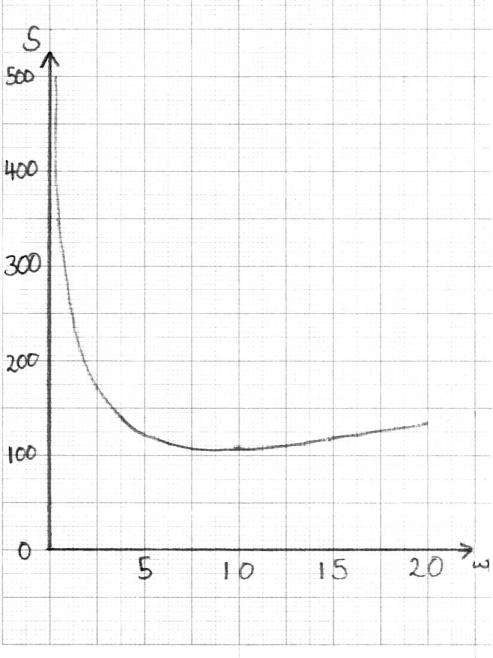 (A1)(A1)(A1)(A1)
(A1)(A1)(A1)(A1)
Note: Award (A1) for correct scales, window and labels on axes, (A1) for approximately correct shape, (A1) for minimum point in approximately correct position, (A1) for asymptotic behaviour at \(w = 0\).
Axes must be drawn with a ruler and labeled \(w\) and \(S\).
For a smooth curve (with approximately correct shape) there should be one continuous thin line, no part of which is straight and no (one-to-many) mappings of \(w\).
The \(S\)-axis must be an asymptote. The curve must not touch the \(S\)-axis nor must the curve approach the asymptote then deviate away later.[4 marks]
\(4 – \frac{{300}}{{{w^2}}}\) (A1)(A1)(A1)
Notes: Award (A1) for \(4\), (A1) for \(-300\), (A1) for \(\frac{1}{{{w^2}}}\) or \({w^{ – 2}}\). If extra terms present, award at most (A1)(A1)(A0). [3 marks]
\(4 – \frac{{300}}{{{w^2}}} = 0\) OR \(\frac{{300}}{{{w^2}}} = 4\) OR \(\frac{{{\text{d}}S}}{{{\text{d}}w}} = 0\) (M1)
Note: Award (M1) for equating their derivative to zero.
\(w = 8.66{\text{ }}\left( {\sqrt {75} ,{\text{ 8.66025}} \ldots } \right)\) (A1)(ft)(G2)
Note: Follow through from their answer to part (e).[2 marks]
\(17.3 \left( {\frac{{150}}{{\sqrt {75} }},{\text{ 17.3205}} \ldots } \right)\) (A1)(ft)
Note: Follow through from their answer to part (f).[1 mark]
\(40 + 4\sqrt {75} + \frac{{300}}{{\sqrt {75} }}\) (M1)
Note: Award (M1) for substitution of their answer to part (f) into the expression for \(S\).
\( = 110{\text{ (cm) }}\left( {40 + 40\sqrt 3 ,{\text{ 109.282}} \ldots } \right)\) (A1)(ft)(G2)
Note: Do not accept \(109\).
Follow through from their answers to parts (f) and (g).[2 marks]
Question
Consider the function \(f(x) = 0.5{x^2} – \frac{8}{x},{\text{ }}x \ne 0\).
Find \(f( – 2)\).[2]
Find \(f'(x)\).[3]
Find the gradient of the graph of \(f\) at \(x = – 2\).[2]
Let \(T\) be the tangent to the graph of \(f\) at \(x = – 2\).
Write down the equation of \(T\).[2]
Let \(T\) be the tangent to the graph of \(f\) at \(x = – 2\).
Sketch the graph of \(f\) for \( – 5 \leqslant x \leqslant 5\) and \( – 20 \leqslant y \leqslant 20\).[4]
Let \(T\) be the tangent to the graph of \(f\) at \(x = – 2\).
Draw \(T\) on your sketch.[2]
The tangent, \(T\), intersects the graph of \(f\) at a second point, P.
Use your graphic display calculator to find the coordinates of P.[2]
Answer/Explanation
Markscheme
\(0.5 \times {( – 2)^2} – \frac{8}{{ – 2}}\) (M1)
Note: Award (M1) for substitution of \(x = – 2\) into the formula of the function.
\(6\) (A1)(G2)
\(f'(x) = x + 8{x^{ – 2}}\) (A1)(A1)(A1)
Notes: Award (A1) for \(x\), (A1) for \(8\), (A1) for \({x^{ – 2}}\) or \(\frac{1}{{{x^2}}}\) (each term must have correct sign). Award at most (A1)(A1)(A0) if there are additional terms present or further incorrect simplifications are seen.
\(f'( – 2) = – 2 + 8{( – 2)^{ – 2}}\) (M1)
Note: Award (M1) for \(x = – 2\) substituted into their \(f'(x)\) from part (b).
\( = 0\) (A1)(ft)(G2)
Note: Follow through from their derivative function.
\(y = 6\;\;\;\)OR\(\;\;\;y = 0x + 6\;\;\;\)OR\(\;\;\;y – 6 = 0(x + 2)\) (A1)(ft)(A1)(ft)(G2)
Notes: Award (A1)(ft) for their gradient from part (c), (A1)(ft) for their answer from part (a). Answer must be an equation.
Award (A0)(A0) for \(x = 6\).
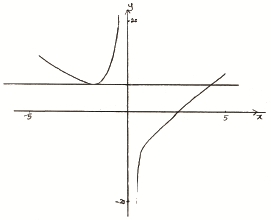 (A1)(A1)(A1)(A1)
(A1)(A1)(A1)(A1)
Notes: Award (A1) for labels and some indication of scales in the stated window. The point \((-2,{\text{ }}6)\) correctly labelled, or an \(x\)-value and a \(y\)-value on their axes in approximately the correct position, are acceptable indication of scales.
Award (A1) for correct general shape (curve must be smooth and must not cross the \(y\)-axis).
Award (A1) for \(x\)-intercept in approximately the correct position.
Award (A1) for local minimum in the second quadrant.
Tangent to graph drawn approximately at \(x = – 2\) (A1)(ft)(A1)(ft)
Notes: Award (A1)(ft) for straight line tangent to curve at approximately \(x = – 2\), with approximately correct gradient. Tangent must be straight for the (A1)(ft) to be awarded.
Award (A1)(ft) for (extended) line passing through approximately their \(y\)-intercept from (d). Follow through from their gradient in part (c) and their equation in part (d).
\((4,{\text{ }}6)\;\;\;\)OR\(\;\;\;x = 4,{\text{ }}y = 6\) (G1)(ft)(G1)(ft)
Notes: Follow through from their tangent from part (d). If brackets are missing then award (G0)(G1)(ft).
If line intersects their graph at more than one point (apart from \(( – 2,{\text{ }}6)\)), follow through from the first point of intersection (to the right of \( – 2\)).
Award (G0)(G0) for \(( – 2,{\text{ }}6)\).
Question
A distress flare is fired into the air from a ship at sea. The height, \(h\) , in metres, of the flare above sea level is modelled by the quadratic function
\[h\,(t) = – 0.2{t^2} + 16t + 12\,,\,t \geqslant 0\,,\]
where \(t\) is the time, in seconds, and \(t = 0\,\) at the moment the flare was fired.
Write down the height from which the flare was fired.[1]
Find the height of the flare \(15\) seconds after it was fired.[2]
The flare fell into the sea \(k\) seconds after it was fired.
Find the value of \(k\) .[2]
Find \(h’\,(t)\,.\)[2]
i) Show that the flare reached its maximum height \(40\) seconds after being fired.
ii) Calculate the maximum height reached by the flare.[3]
The nearest coastguard can see the flare when its height is more than \(40\) metres above sea level.
Determine the total length of time the flare can be seen by the coastguard.[3]
Answer/Explanation
Markscheme
\(12\,({\text{m}})\) (A1)
\((h\,(15) = ) – 0.2 \times {15^2} + 16 \times 15 + 12\) (M1)
Note: Award (M1) for substitution of \(15\) in expression for \(h\).
\( = 207\,({\text{m}})\) (A1)(G2)
\(h\,(k) = 0\) (M1)
Note: Award (M1) for setting \(h\) to zero.
\((k = )\,\,\,80.7\,({\text{s}})\,\,\,(80.7430)\) (A1)(G2)
Note: Award at most (M1)(A0) for an answer including \(K = – 0.743\) .
Award (A0) for an answer of \(80\) without working.
\(h’\,(t) = – 0.4t + 16\) (A1)(A1)
Note: Award (A1) for \( – 0.4t\), (A1) for \(16\). Award at most (A1)(A0) if extra terms seen. Do not accept \(x\) for \(t\).
i) \( – 0.4t + 16 = 0\) (M1)
Note: Award (M1) for setting their derivative, from part (d), to zero, provided the correct conclusion is stated and consistent with their \(h’\,(t)\).
OR
\(t = \frac{{ – 16}}{{2 \times ( – 0.2)}}\) (M1)
Note: Award (M1) for correct substitution into axis of symmetry formula, provided the correct conclusion is stated.
\(t = \,\,40\,({\text{s}})\) (AG)
ii) \( – 0.2 \times {40^2} + 16 \times 40 + 12\) (M1)
Note: Award (M1) for substitution of \(40\) in expression for \(h\).
\( = 332\,({\text{m}})\) (A1)(G2)
\(h\,(t) = 40\) (M1)
Note: Award (M1) for setting \(h\) to \(40\). Accept inequality sign.
OR
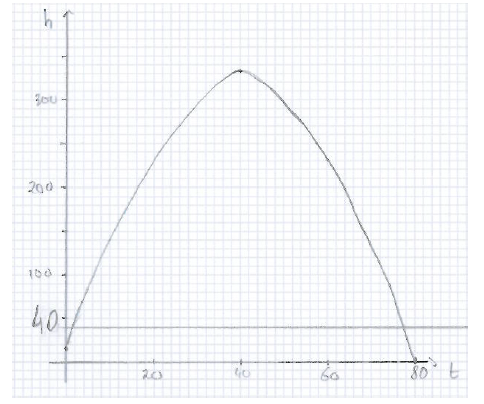
M1
Note: Award (M1) for correct sketch. Indication of scale is not required.
\(78.2 – 1.17\,\,(78.2099…\,\, – 1.79005…)\) (A1)
Note: Award (A1) for \(1.79\) and \(78.2\) seen.
(total time \( = \)) \(76.4\,({\text{s}})\,\,\,(76.4198…)\) (A1)(G2)
Note: Award (G1) if the two endpoints are given as the final answer with no working.
Question
A function, \(f\) , is given by
\[f(x) = 4 \times {2^{ – x}} + 1.5x – 5.\]
Calculate \(f(0)\)[2]
Use your graphic display calculator to solve \(f(x) = 0.\)[2]
Sketch the graph of \(y = f(x)\) for \( – 2 \leqslant x \leqslant 6\) and \( – 4 \leqslant y \leqslant 10\) , showing the \(x\) and \(y\) intercepts. Use a scale of \(2\,{\text{cm}}\) to represent \(2\) units on both the horizontal axis, \(x\) , and the vertical axis, \(y\) .[4]
The function \(f\) is the derivative of a function \(g\) . It is known that \(g(1) = 3.\)
i) Calculate \(g'(1).\)
ii) Find the equation of the tangent to the graph of \(y = g(x)\) at \(x = 1.\) Give your answer in the form \(y = mx + c.\)[4]
Answer/Explanation
Markscheme
\(4 \times {2^{ – 0}} + 1.5 \times 0 – 5\) (M1)
Note: Award (M1) for substitution of \(0\) into the expression for \(f(x)\) .
\( = – 1\) (A1)(G2)
\( – 0.538\,\,\,( – 0.537670…)\) and \(3\) (A1)(A1)
Note: Award at most (A0)(A1)(ft) if answer is given as pairs of coordinates.
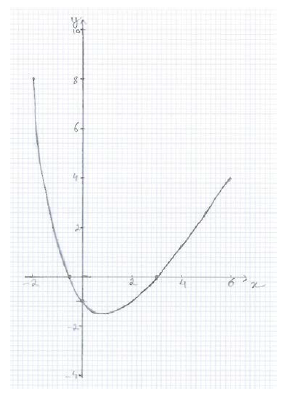
(A1)(A1)(A1)(ft)(A1)(ft)
Note: Award (A1) for labels and some indication of scale in the correct given window.
Award (A1) for smooth curve with correct general shape with \(f( – 2) > f(6)\) and minimum to the right of the \(y\)-axis.
Award (A1)(ft) for correct \(y\)-intercept (consistent with their part (a)).
Award (A1)(ft) for approximately correct \(x\)-intercepts (consistent with their part (b), one zero between \( – 1\) and \(0\), the other between \(2.5\) and \(3.5\)).
i) \(g'(1) = f(1) = 4 \times {2^{ – 1}} + 1.5 – 5\) (M1)
Note: Award (M1) for substitution of \(1\) into \(f(x)\).
\( = – 1.5\) (A1)(G2)
ii) \(3 = – 1.5 \times 1 + c\) OR \((y – 3) = – 1.5\,(x – 1)\) (M1)
Note: Award (M1) for correct substitution of gradient and the point \((1,\,\,3)\) into the equation of a line. Follow through from (d)(i).
\(y = – 1.5x + 4.5\) (A1)(ft)(G2)
Question
Hugo is given a rectangular piece of thin cardboard, \(16\,{\text{cm}}\) by \(10\,{\text{cm}}\). He decides to design a tray with it.
He removes from each corner the shaded squares of side \(x\,{\text{cm}}\), as shown in the following diagram.
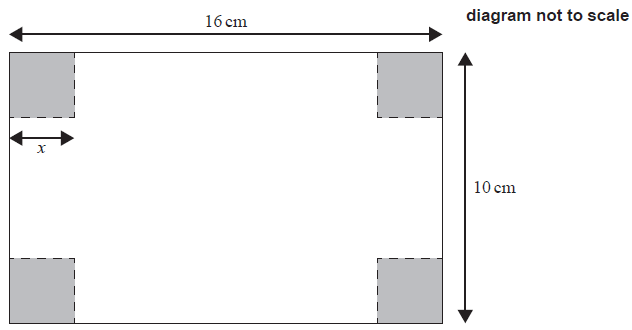
The remainder of the cardboard is folded up to form the tray as shown in the following diagram.

Write down, in terms of \(x\) , the length and the width of the tray.[2]
(i) State whether \(x\) can have a value of \(5\). Give a reason for your answer.
(ii) Write down the interval for the possible values of \(x\) .[4]
Show that the volume, \(V\,{\text{c}}{{\text{m}}^3}\), of this tray is given by
\[V = 4{x^3} – 52{x^2} + 160x.\][2]
Find \(\frac{{dV}}{{dx}}.\)[3]
Using your answer from part (d), find the value of \(x\) that maximizes the volume of the tray.[2]
Calculate the maximum volume of the tray.[2]
Sketch the graph of \(V = 4{x^3} – 51{x^2} + 160x\) , for the possible values of \(x\) found in part (b)(ii), and \(0 \leqslant V \leqslant 200\) . Clearly label the maximum point.[4]
Answer/Explanation
Markscheme
\(16 – 2x,\,\,10 – 2x\) (A1)(A1)
(i) no (A1)
(when \(x\) is \(5\)) the width of the tray will be zero / there is no short edge to fold / \(10 – 2\,(5) = 0\) (R1)
Note: Do not award (R0)(A1). Award the (R1) for reasonable explanation.
(ii) \(0 < x < 5\) (A1)(A1)
Note: Award (A1) for \(0\) and \(5\) seen, (A1) for correct strict inequalities (accept alternative notation). Award (A1)(A0) for “between \(0\) and \(5\)” or “from \(0\) to \(5\)”.
Do not accept a list of integers.
\(V = (16 – 2x)\,(10 – 2x)\,(x)\) (M1)
Note: Award (M1) for their correct substitution in volume of cuboid formula.
\( = 160x – 32{x^2} – 20{x^2} + 4{x^3}\) (or equivalent) (M1)
\( = 160x – 52{x^2} + 4{x^3}\) (AG)
Note: Award (M1) for showing clearly the expansion and for simplifying the expression, and this must be seen to award second (M1). The (AG) line must be seen for the final (M1) to be awarded.
\(12{x^2} – 104x + 160\) (or equivalent) (A1)(A1)(A1)
Note: Award (A1) for \(12{x^2}\), (A1) for \( – 104x\) and (A1) for \( + 160\). If extra terms are seen award at most (A1)(A1)(A0).
\(12{x^2} – 104x + 160 = 0\) (M1)
Note: Award (M1) for equating their derivative to \(0\).
\(x = 2\) (A1)(ft)
Note: Award (M1) for a sketch of their derivative in part (d), (A1)(ft) for reading the \(x\)-intercept from their graph.
Award (M0)(A0) for \(x = 2\) with no working seen.
Award at most (M1)(A0) if the answer is a pair of coordinates.
Award at most (M1)(A0) if the answer given is \(x = 2\) and \(x = \frac{{20}}{3}\)
Follow through from their derivative in part (d). Award (A1)(ft) only if answer is positive and less than \(5\).
\(4{(2)^3} – 52{(2)^2} + 160(2)\) (M1)
Note: Award (M1) for correct substitution of their answer to part (e) into volume formula.
\(144\,({\text{c}}{{\text{m}}^3})\) (A1)(ft)(G2)
Note: Follow through from part (d).
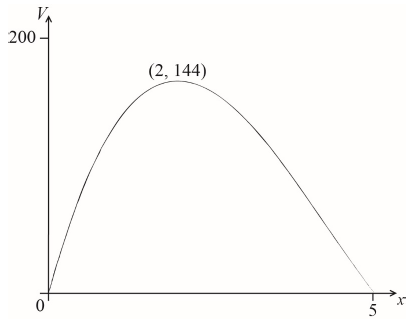
(A1)(A1)(ft)(A1)(A1)(ft)
Note: Award (A1) for correctly labelled axes and window for \(V\), ie \(0 \leqslant V \leqslant 200\).
Award (A1)(ft) for the correct domain \((0 < x < 5)\). Follow through from part (b)(ii) if a different domain is shown on graph.
Award (A1) for smooth curve with correct shape.
Award (A1)(ft) for their maximum point indicated (coordinates, cross or dot etc.) in approximately correct place.
Follow through from parts (e) and (f) only if the maximum on their graph is different from \((2,\,\,144)\).
Question
The line \({L_1}\) has equation \(2y – x – 7 = 0\) and is shown on the diagram.
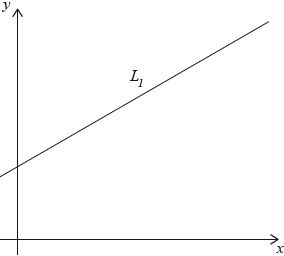
The point A has coordinates \((1,{\text{ }}4)\).
The point C has coordinates \((5,{\text{ }}12)\). M is the midpoint of AC.
The straight line, \({L_2}\), is perpendicular to AC and passes through M.
The point D is the intersection of \({L_1}\) and \({L_2}\).
The length of MD is \(\frac{{\sqrt {45} }}{2}\).
The point B is such that ABCD is a rhombus.
Show that A lies on \({L_1}\).[2]
Find the coordinates of M.[2]
Find the length of AC.[2]
Show that the equation of \({L_2}\) is \(2y + x – 19 = 0\).[5]
Find the coordinates of D.[2]
Write down the length of MD correct to five significant figures.[1]
Find the area of ABCD.[3]
Answer/Explanation
Markscheme
\(2 \times 4 – 1 – 7 = 0\) (or equivalent) (R1)
Note: For (R1) accept substitution of \(x = 1\) or \(y = 4\) into the equation followed by a confirmation that \(y = 4\) or \(x = 1\).
(since the point satisfies the equation of the line,) A lies on \({L_1}\) (A1)
Note: Do not award (A1)(R0).[2 marks]
\(\frac{{1 + 5}}{2}\) OR \(\frac{{4 + 12}}{2}\) seen (M1)
Note: Award (M1) for at least one correct substitution into the midpoint formula.
\((3,{\text{ }}8)\) (A1)(G2)
Notes: Accept \(x = 3,{\text{ }}y = 8\).
Award (M1)(A0) for \(\left( {\frac{{1 + 5}}{2},{\text{ }}\frac{{4 + 12}}{2}} \right)\).
Award (G1) for each correct coordinate seen without working.[2 marks]
\(\sqrt {{{(5 – 1)}^2} + {{(12 – 4)}^2}} \) (M1)
Note: Award (M1) for a correct substitution into distance between two points formula.
\( = 8.94{\text{ }}\left( {4\sqrt 5 ,{\text{ }}\sqrt {80} ,{\text{ }}8.94427 \ldots } \right)\) (A1)(G2)[2 marks]
gradient of \({\text{AC}} = \frac{{12 – 4}}{{5 – 1}}\) (M1)
Note: Award (M1) for correct substitution into gradient formula.
\( = 2\) (A1)
Note: Award (M1)(A1) for gradient of \({\text{AC}} = 2\) with or without working
gradient of the normal \( = – \frac{1}{2}\) (M1)
Note: Award (M1) for the negative reciprocal of their gradient of AC.
\(y – 8 = – \frac{1}{2}(x – 3)\) OR \(8 = – \frac{1}{2}(3) + c\) (M1)
Note: Award (M1) for substitution of their point and gradient into straight line formula. This (M1) can only be awarded where \( – \frac{1}{2}\) (gradient) is correctly determined as the gradient of the normal to AC.
\(2y – 16 = – (x – 3)\) OR \( – 2y + 16 = x – 3\) OR \(2y = – x + 19\) (A1)
Note: Award (A1) for correctly removing fractions, but only if their equation is equivalent to the given equation.
\(2y + x – 19 = 0\) (AG)
Note: The conclusion \(2y + x – 19 = 0\) must be seen for the (A1) to be awarded.
Where the candidate has shown the gradient of the normal to \({\text{AC}} = – 0.5\), award (M1) for \(2(8) + 3 – 19 = 0\) and (A1) for (therefore) \(2y + x – 19 = 0\).
Simply substituting \((3,{\text{ }}8)\) into the equation of \({L_2}\) with no other prior working, earns no marks.[5 marks]
\((6,{\text{ }}6.5)\) (A1)(A1)(G2)
Note: Award (A1) for 6, (A1) for 6.5. Award a maximum of (A1)(A0) if answers are not given as a coordinate pair. Accept \(x = 6,{\text{ }}y = 6.5\).
Award (M1)(A0) for an attempt to solve the two simultaneous equations \(2y – x – 7 = 0\) and \(2y + x – 19 = 0\) algebraically, leading to at least one incorrect or missing coordinate.[2 marks]
3.3541 (A1)
Note: Answer must be to 5 significant figures.[1 mark]
\(2 \times \frac{1}{2} \times \sqrt {80} \times \frac{{\sqrt {45} }}{2}\) (M1)(M1)
Notes: Award (M1) for correct substitution into area of triangle formula.
If their triangle is a quarter of the rhombus then award (M1) for multiplying their triangle by 4.
If their triangle is a half of the rhombus then award (M1) for multiplying their triangle by 2.
OR
\(\frac{1}{2} \times \sqrt {80} \times \sqrt {45} \) (M1)(M1)
Notes: Award (M1) for doubling MD to get the diagonal BD, (M1) for correct substitution into the area of a rhombus formula.
Award (M1)(M1) for \(\sqrt {80} \times \) their (f).
\( = 30\) (A1)(ft)(G3)
Notes: Follow through from parts (c) and (f).
\(8.94 \times 3.3541 = 29.9856 \ldots \)[3 marks]
Question
A water container is made in the shape of a cylinder with internal height \(h\) cm and internal base radius \(r\) cm.
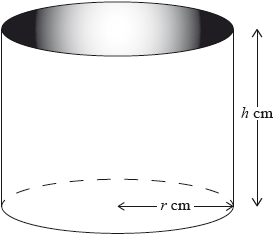
The water container has no top. The inner surfaces of the container are to be coated with a water-resistant material.
The volume of the water container is \(0.5{\text{ }}{{\text{m}}^3}\).
The water container is designed so that the area to be coated is minimized.
One can of water-resistant material coats a surface area of \(2000{\text{ c}}{{\text{m}}^2}\).
Write down a formula for \(A\), the surface area to be coated.[2]
Express this volume in \({\text{c}}{{\text{m}}^3}\).[1]
Write down, in terms of \(r\) and \(h\), an equation for the volume of this water container.[1]
Show that \(A = \pi {r^2}\frac{{1\,000\,000}}{r}\).[2]
Show that \(A = \pi {r^2} + \frac{{1\,000\,000}}{r}\).[2]
Find \(\frac{{{\text{d}}A}}{{{\text{d}}r}}\).[3]
Using your answer to part (e), find the value of \(r\) which minimizes \(A\).[3]
Find the value of this minimum area.[2]
Find the least number of cans of water-resistant material that will coat the area in part (g).[3]
Answer/Explanation
Markscheme
\((A = ){\text{ }}\pi {r^2} + 2\pi rh\) (A1)(A1)
Note: Award (A1) for either \(\pi {r^2}\) OR \(2\pi rh\) seen. Award (A1) for two correct terms added together.[2 marks]
\(500\,000\) (A1)
Notes: Units not required.[1 mark]
\(500\,000 = \pi {r^2}h\) (A1)(ft)
Notes: Award (A1)(ft) for \(\pi {r^2}h\) equating to their part (b).
Do not accept unless \(V = \pi {r^2}h\) is explicitly defined as their part (b).[1 mark]
\(A = \pi {r^2} + 2\pi r\left( {\frac{{500\,000}}{{\pi {r^2}}}} \right)\) (A1)(ft)(M1)
Note: Award (A1)(ft) for their \({\frac{{500\,000}}{{\pi {r^2}}}}\) seen.
Award (M1) for correctly substituting only \({\frac{{500\,000}}{{\pi {r^2}}}}\) into a correct part (a).
Award (A1)(ft)(M1) for rearranging part (c) to \(\pi rh = \frac{{500\,000}}{r}\) and substituting for \(\pi rh\) in expression for \(A\).
\(A = \pi {r^2} + \frac{{1\,000\,000}}{r}\) (AG)
Notes: The conclusion, \(A = \pi {r^2} + \frac{{1\,000\,000}}{r}\), must be consistent with their working seen for the (A1) to be awarded.
Accept \({10^6}\) as equivalent to \({1\,000\,000}\).[2 marks]
\(A = \pi {r^2} + 2\pi r\left( {\frac{{500\,000}}{{\pi {r^2}}}} \right)\) (A1)(ft)(M1)
Note: Award (A1)(ft) for their \({\frac{{500\,000}}{{\pi {r^2}}}}\) seen.
Award (M1) for correctly substituting only \({\frac{{500\,000}}{{\pi {r^2}}}}\) into a correct part (a).
Award (A1)(ft)(M1) for rearranging part (c) to \(\pi rh = \frac{{500\,000}}{r}\) and substituting for \(\pi rh\) in expression for \(A\).
\(A = \pi {r^2} + \frac{{1\,000\,000}}{r}\) (AG)
Notes: The conclusion, \(A = \pi {r^2} + \frac{{1\,000\,000}}{r}\), must be consistent with their working seen for the (A1) to be awarded.
Accept \({10^6}\) as equivalent to \({1\,000\,000}\).[2 marks]
\(2\pi r – \frac{{{\text{1}}\,{\text{000}}\,{\text{000}}}}{{{r^2}}}\) (A1)(A1)(A1)
Note: Award (A1) for \(2\pi r\), (A1) for \(\frac{1}{{{r^2}}}\) or \({r^{ – 2}}\), (A1) for \( – {\text{1}}\,{\text{000}}\,{\text{000}}\).[3 marks]
\(2\pi r – \frac{{1\,000\,000}}{{{r^2}}} = 0\) (M1)
Note: Award (M1) for equating their part (e) to zero.
\({r^3} = \frac{{1\,000\,000}}{{2\pi }}\) OR \(r = \sqrt[3]{{\frac{{1\,000\,000}}{{2\pi }}}}\) (M1)
Note: Award (M1) for isolating \(r\).
OR
sketch of derivative function (M1)
with its zero indicated (M1)
\((r = ){\text{ }}54.2{\text{ }}({\text{cm}}){\text{ }}(54.1926 \ldots )\) (A1)(ft)(G2)[3 marks]
\(\pi {(54.1926 \ldots )^2} + \frac{{1\,000\,000}}{{(54.1926 \ldots )}}\) (M1)
Note: Award (M1) for correct substitution of their part (f) into the given equation.
\( = 27\,700{\text{ }}({\text{c}}{{\text{m}}^2}){\text{ }}(27\,679.0 \ldots )\) (A1)(ft)(G2)[2 marks]
\(\frac{{27\,679.0 \ldots }}{{2000}}\) (M1)
Note: Award (M1) for dividing their part (g) by 2000.
\( = 13.8395 \ldots \) (A1)(ft)
Notes: Follow through from part (g).
14 (cans) (A1)(ft)(G3)
Notes: Final (A1) awarded for rounding up their \(13.8395 \ldots \) to the next integer.[3 marks]
Question
Consider the function \(f(x) = 0.3{x^3} + \frac{{10}}{x} + {2^{ – x}}\).
Consider a second function, \(g(x) = 2x – 3\).
Calculate \(f(1)\).[2]
Sketch the graph of \(y = f(x)\) for \( – 7 \leqslant x \leqslant 4\) and \( – 30 \leqslant y \leqslant 30\).[4]
Write down the equation of the vertical asymptote.[2]
Write down the coordinates of the \(x\)-intercept.[2]
Write down the possible values of \(x\) for which \(x < 0\) and \(f’(x) > 0\).[2]
Find the solution of \(f(x) = g(x)\).[2]
Answer/Explanation
Markscheme
\(0.3{(1)^3} + \frac{{10}}{1} + {2^{ – 1}}\) (M1)
Note: Award (M1) for correct substitution into function.
\( = 10.8\) (A1)(G2)[2 marks]
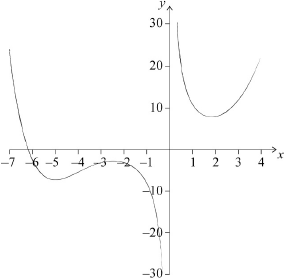 (A1)(A1)(A1)(A1)
(A1)(A1)(A1)(A1)
Note: Award (A1) for indication of correct window and labelled axes.
Award (A1) for correct shape and position for \(x < 0\) (with the local maximum, local minimum and \(x\)-intercept in relative approximate location in \({{\text{3}}^{{\text{rd}}}}\) quadrant).
Award (A1) for correct shape and position for \(x > 0\) (with the local minimum in relative approximate location in \({{\text{1}}^{{\text{st}}}}\) quadrant).
Award (A1) for smooth curve with indication of asymptote (graph should not touch \(y\)-axis and should not curve away from the \(y\)-axis). The asymptote is only assessed in this mark.[4 marks]
\(x = 0\) (A2)
Note: Award (A1) for “\(x = {\text{(a constant)}}\)” and (A1) for “\({\text{(a constant)}} = 0\)”.
The answer must be an equation.[2 marks]
\(( – 6.18,{\text{ }}0){\text{ }}( – 6.17516 \ldots ,{\text{ }}0)\) (A1)(A1)
Note: Award (A1) for each correct coordinate. Award (A0)(A1) if parentheses are missing.[2 marks]
\( – 4.99 < x < – 2.47{\text{ }}( – 4.98688 \ldots < x < – 2.46635 \ldots )\) (A1)(A1)
Note: Award (A1) for both correct end points, (A1) for strict inequalities used with 2 endpoints.[2 marks]
\(0.3{x^3} + \frac{{10}}{x} + {2^{ – x}} = 2x – 3\) (M1)
Note: Award (M1) for equating the expressions for \(f\) and \(g\) or for the line \(y = 2x – 3\) sketched (positive gradient, negative \(y\)-intercept) on their graph from part (a).
\((x = ){\text{ }} – 1.34{\text{ }}( – 1.33650 \ldots )\) (A1)(G2)
Note: Award a maximum of (M1)(A0) or (G1) for coordinate pair seen as final answer.[2 marks]
Question
Consider the function \(f(x) = – {x^4} + a{x^2} + 5\), where \(a\) is a constant. Part of the graph of \(y = f(x)\) is shown below.
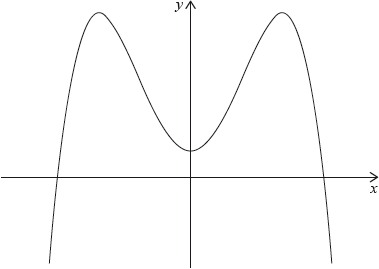
It is known that at the point where \(x = 2\) the tangent to the graph of \(y = f(x)\) is horizontal.
There are two other points on the graph of \(y = f(x)\) at which the tangent is horizontal.
Write down the \(y\)-intercept of the graph.[1]
Find \(f'(x)\).[2]
Show that \(a = 8\).[2]
Find \(f(2)\).[2]
Write down the \(x\)-coordinates of these two points;[2]
Write down the intervals where the gradient of the graph of \(y = f(x)\) is positive.[2]
Write down the range of \(f(x)\).[2]
Write down the number of possible solutions to the equation \(f(x) = 5\).[1]
The equation \(f(x) = m\), where \(m \in \mathbb{R}\), has four solutions. Find the possible values of \(m\).[2]
Answer/Explanation
Markscheme
5 (A1)
Note: Accept an answer of \((0,{\text{ }}5)\).
[1 mark]
\(\left( {f'(x) = } \right) – 4{x^3} + 2ax\) (A1)(A1)
Note: Award (A1) for \( – 4{x^3}\) and (A1) for \( + 2ax\). Award at most (A1)(A0) if extra terms are seen.[2 marks]
\( – 4 \times {2^3} + 2a\times 2 = 0\) (M1)(M1)
Note: Award (M1) for substitution of \(x = 2\) into their derivative, (M1) for equating their derivative, written in terms of \(a\), to 0 leading to a correct answer (note, the 8 does not need to be seen).
\(a = 8\) (AG)[2 marks]
\(\left( {f(2) = } \right) – {2^4} + 8 \times {2^2} + 5\) (M1)
Note: Award (M1) for correct substitution of \(x = 2\) and \(a = 8\) into the formula of the function.
21 (A1)(G2)[2 marks]
\((x = ){\text{ }} – 2,{\text{ }}(x = ){\text{ 0}}\) (A1)(A1)
Note: Award (A1) for each correct solution. Award at most (A0)(A1)(ft) if answers are given as \(( – 2{\text{ }},21)\) and \((0,{\text{ }}5)\) or \(( – 2,{\text{ }}0)\) and \((0,{\text{ }}0)\).[2 marks]
\(x < – 2,{\text{ }}0 < x < 2\) (A1)(ft)(A1)(ft)
Note: Award (A1)(ft) for \(x < – 2\), follow through from part (d)(i) provided their value is negative.
Award (A1)(ft) for \(0 < x < 2\), follow through only from their 0 from part (d)(i); 2 must be the upper limit.
Accept interval notation.[2 marks]
\(y \leqslant 21\) (A1)(ft)(A1)
Notes: Award (A1)(ft) for 21 seen in an interval or an inequality, (A1) for “\(y \leqslant \)”.
Accept interval notation.
Accept \( – \infty < y \leqslant 21\) or \(f(x) \leqslant 21\).
Follow through from their answer to part (c)(ii). Award at most (A1)(ft)(A0) if \(x\) is seen instead of \(y\). Do not award the second (A1) if a (finite) lower limit is seen.[2 marks]
3 (solutions) (A1)
[1 mark]
\(5 < m < 21\) or equivalent (A1)(ft)(A1)
Note: Award (A1)(ft) for 5 and 21 seen in an interval or an inequality, (A1) for correct strict inequalities. Follow through from their answers to parts (a) and (c)(ii).
Accept interval notation.[2 marks]
Question
A function \(f\) is given by \(f(x) = (2x + 2)(5 – {x^2})\).
The graph of the function \(g(x) = {5^x} + 6x – 6\) intersects the graph of \(f\).
Find the exact value of each of the zeros of \(f\).[3]
Expand the expression for \(f(x)\).[1]
Find \(f’(x)\).[3]
Use your answer to part (b)(ii) to find the values of \(x\) for which \(f\) is increasing.[3]
Draw the graph of \(f\) for \( – 3 \leqslant x \leqslant 3\) and \( – 40 \leqslant y \leqslant 20\). Use a scale of 2 cm to represent 1 unit on the \(x\)-axis and 1 cm to represent 5 units on the \(y\)-axis.[4]
Write down the coordinates of the point of intersection.[2]
Answer/Explanation
Markscheme
\( – 1,{\text{ }}\sqrt 5 ,{\text{ }} – \sqrt 5 \) (A1)(A1)(A1)
Note: Award (A1) for –1 and each exact value seen. Award at most (A1)(A0)(A1) for use of 2.23606… instead of \(\sqrt 5 \).[3 marks]
\(10x – 2{x^3} + 10 – 2{x^2}\) (A1)
Notes: The expansion may be seen in part (b)(ii).[1 mark]
\(10 – 6{x^2} – 4x\) (A1)(ft)(A1)(ft)(A1)(ft)
Notes: Follow through from part (b)(i). Award (A1)(ft) for each correct term. Award at most (A1)(ft)(A1)(ft)(A0) if extra terms are seen.[3 marks]
\(10 – 6{x^2} – 4x > 0\) (M1)
Notes: Award (M1) for their \(f’(x) > 0\). Accept equality or weak inequality.
\( – 1.67 < x < 1{\text{ }}\left( { – \frac{5}{3} < x < 1,{\text{ }} – 1.66666 \ldots < x < 1} \right)\) (A1)(ft)(A1)(ft)(G2)
Notes: Award (A1)(ft) for correct endpoints, (A1)(ft) for correct weak or strict inequalities. Follow through from part (b)(ii). Do not award any marks if there is no answer in part (b)(ii).[3 marks]
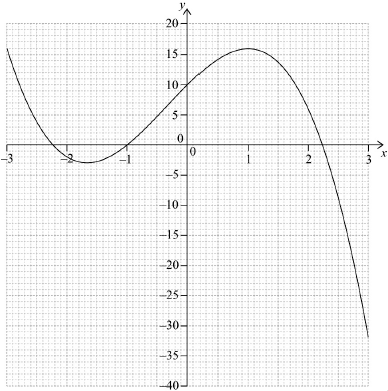 (A1)(A1)(ft)(A1)(ft)(A1)
(A1)(A1)(ft)(A1)(ft)(A1)
Notes: Award (A1) for correct scale; axes labelled and drawn with a ruler.
Award (A1)(ft) for their correct \(x\)-intercepts in approximately correct location.
Award (A1) for correct minimum and maximum points in approximately correct location.
Award (A1) for a smooth continuous curve with approximate correct shape. The curve should be in the given domain.
Follow through from part (a) for the \(x\)-intercepts.[4 marks]
\((1.49,{\text{ }}13.9){\text{ }}\left( {(1.48702 \ldots ,{\text{ }}13.8714 \ldots )} \right)\) (G1)(ft)(G1)(ft)
Notes: Award (G1) for 1.49 and (G1) for 13.9 written as a coordinate pair. Award at most (G0)(G1) if parentheses are missing. Accept \(x = 1.49\) and \(y = 13.9\). Follow through from part (b)(i).[2 marks]
Question
Consider the function \(f\left( x \right) = \frac{{48}}{x} + k{x^2} – 58\), where x > 0 and k is a constant.
The graph of the function passes through the point with coordinates (4 , 2).
P is the minimum point of the graph of f (x).
Find the value of k.[2]
Using your value of k , find f ′(x).[3]
Use your answer to part (b) to show that the minimum value of f(x) is −22 .[3]
Write down the two values of x which satisfy f (x) = 0.[2]
Sketch the graph of y = f (x) for 0 < x ≤ 6 and −30 ≤ y ≤ 60.
Clearly indicate the minimum point P and the x-intercepts on your graph.[4]
Answer/Explanation
Markscheme
\(\frac{{48}}{4} + k \times {4^2} – 58 = 2\) (M1)
Note: Award (M1) for correct substitution of x = 4 and y = 2 into the function.
k = 3 (A1) (G2)[2 marks]
\(\frac{{ – 48}}{{{x^2}}} + 6x\) (A1)(A1)(A1)(ft) (G3)
Note: Award (A1) for −48 , (A1) for x−2, (A1)(ft) for their 6x. Follow through from part (a). Award at most (A1)(A1)(A0) if additional terms are seen.[3 marks]
\(\frac{{ – 48}}{{{x^2}}} + 6x = 0\) (M1)
Note: Award (M1) for equating their part (b) to zero.
x = 2 (A1)(ft)
Note: Follow through from part (b). Award (M1)(A1) for \(\frac{{ – 48}}{{{{\left( 2 \right)}^2}}} + 6\left( 2 \right) = 0\) seen.
Award (M0)(A0) for x = 2 seen either from a graphical method or without working.
\(\frac{{48}}{2} + 3 \times {2^2} – 58\,\,\,\left( { = – 22} \right)\) (M1)
Note: Award (M1) for substituting their 2 into their function, but only if the final answer is −22. Substitution of the known result invalidates the process; award (M0)(A0)(M0).
−22 (AG)[3 marks]
0.861 (0.860548…), 3.90 (3.90307…) (A1)(ft)(A1)(ft) (G2)
Note: Follow through from part (a) but only if the answer is positive. Award at most (A1)(ft)(A0) if answers are given as coordinate pairs or if extra values are seen. The function f (x) only has two x-intercepts within the domain. Do not accept a negative x-intercept.[2 marks]
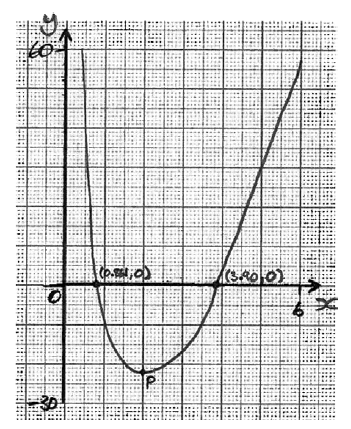 (A1)(A1)(ft)(A1)(ft)(A1)(ft)
(A1)(A1)(ft)(A1)(ft)(A1)(ft)
Note: Award (A1) for correct window. Axes must be labelled.
(A1)(ft) for a smooth curve with correct shape and zeros in approximately correct positions relative to each other.
(A1)(ft) for point P indicated in approximately the correct position. Follow through from their x-coordinate in part (c). (A1)(ft) for two x-intercepts identified on the graph and curve reflecting asymptotic properties.[4 marks]
Question
Consider the curve y = 2x3 − 9x2 + 12x + 2, for −1 < x < 3
Sketch the curve for −1 < x < 3 and −2 < y < 12.[4]
A teacher asks her students to make some observations about the curve.
Three students responded.
Nadia said “The x-intercept of the curve is between −1 and zero”.
Rick said “The curve is decreasing when x < 1 ”.
Paula said “The gradient of the curve is less than zero between x = 1 and x = 2 ”.
State the name of the student who made an incorrect observation.[1]
Find the value of y when x = 1 .[2]
Find \(\frac{{{\text{dy}}}}{{{\text{dx}}}}\).[3]
Show that the stationary points of the curve are at x = 1 and x = 2.[2]
Given that y = 2x3 − 9x2 + 12x + 2 = k has three solutions, find the possible values of k.[3]
Answer/Explanation
Markscheme
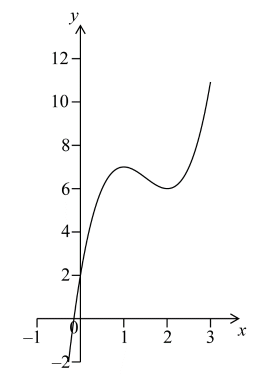 (A1)(A1)(A1)(A1)
(A1)(A1)(A1)(A1)
Note: Award (A1) for correct window (condone a window which is slightly off) and axes labels. An indication of window is necessary. −1 to 3 on the x-axis and −2 to 12 on the y-axis and a graph in that window.
(A1) for correct shape (curve having cubic shape and must be smooth).
(A1) for both stationary points in the 1st quadrant with approximate correct position,
(A1) for intercepts (negative x-intercept and positive y intercept) with approximate correct position.[4 marks]
Rick (A1)
Note: Award (A0) if extra names stated.[1 mark]
2(1)3 − 9(1)2 + 12(1) + 2 (M1)
Note: Award (M1) for correct substitution into equation.
= 7 (A1)(G2)[2 marks]
6x2 − 18x + 12 (A1)(A1)(A1)
Note: Award (A1) for each correct term. Award at most (A1)(A1)(A0) if extra terms seen.[3 marks]
6x2 − 18x + 12 = 0 (M1)
Note: Award (M1) for equating their derivative to 0. If the derivative is not explicitly equated to 0, but a subsequent solving of their correct equation is seen, award (M1).
6(x − 1)(x − 2) = 0 (or equivalent) (M1)
Note: Award (M1) for correct factorization. The final (M1) is awarded only if answers are clearly stated.
Award (M0)(M0) for substitution of 1 and of 2 in their derivative.
x = 1, x = 2 (AG)[2 marks]
6 < k < 7 (A1)(A1)(ft)(A1)
Note: Award (A1) for an inequality with 6, award (A1)(ft) for an inequality with 7 from their part (c) provided it is greater than 6, (A1) for their correct strict inequalities. Accept ]6, 7[ or (6, 7).[3 marks]
